Back in my school days, many lessons in History/Social Science textbooks looked irrelevant and difficult for me to learn and process. One such topic was about Trans Siberian railways and I vaguely remember memorizing it with the usual dislike – to be more precise. I think many would agree with me having similar learning experiences. All I remembered about Trans Siberian Railway was its association with Russia. It would have never been listed in my bucket list until I came across an Instagram ad posted by a Madurai based travel agent, Sky Planet Holidays inviting travellers for a Trans Siberian train tour.
As I read the tentative itinerary, my urge to explore novel travel routes elicited my interest. The itinerary talked about a train tour covering 2 continents and 3 countries starting from Moscow (west of Russia) chugging through Siberia (east of Russia) and Mongolia before reaching Beijing in China. Three days of stay in Moscow city and then boarding the world’s longest train route -100hrs of train journey covering 6000kms (that includes 5 nights of travel spanning over 6 time zones) with 4 nights break in three Siberian cities namely Eketerinberg, Krasnoyarsk and Irkutsk and finally disembarking in Ulaan Baatar, Mongolia. After a night stay in Ulaan Baatar, flying to Beijing, China before returning to Chennai, India. What more could a hodophile ask for!!!… As excitement mounted, I searched for blogs on Trans Siberian railways and found only a few written by mostly adventurous westeners. One thing was for sure: if I opt to go, this would probably be one of the most challenging trips I have ever done so far.
My wife insisted to meet my travel agent to clarify her concerns about my safety and comfort. I could realise that the tour manger himself was clueless as this was their first experience in this circuit. Thanks to SkyPlanet Holidays and Mr.Vignesh, co-director and our tour manager, this trip turned out to be one of the most memorable trip in my life.
Short history of Russia
Russia became more isolated from rest of the world during the cold war and due to language barrier. Many of us knew Russia only through media news especially when our leaders and bureaucrats visit here despite Russia being India’s most favorite country for decades. We were probably overwhelmed with western influences and never attempted to learn about Russian history or culture.
After the collapse of Soviet union in 1991, many tourists felt comfortable visiting Moscow and Petersburg and discovered the culture and infrastructure to be similar to other European destinations. There can be no truly enriching way to experience Russia other than travelling by Trans Siberian train touching almost all major underrated Russian cities. It was absolutely hard to communicate but whatever interactions and experiences we had during our long train journeys and during our stay in the cities enroute was an eye opener comprehending the true culture, food, history, current economy and politics of Russia. Please allow me start with a short timeline of Russian history as a mark of respect to this wonderful but often ignored country.
- The early human settlement in Russia is believed to have begun in 5th century CE when the east Slavs and/or Scandinevian Viking conquerers settled in today’s Kiev City in Ukraine and expanded their occupation around Ukraine, Belarus and Muscovy (East of Russia).
- The origin of Russian language spoken today is Slavic and so historians believe the roots of Russians are more eastern Slavs settlers. The Russian script comes from Cyrillic.
- The Kievs were influenced by the Byzantines (East Romans-10th century CE) and adopted orthodox Christianity in 988CE.
- Muscovy fell to Mongol invaders in mid 13th century when the Golden Horde was established by Batu Khan (grandson of the great Mongol conquerer Genghis Khan)
- Ivan-III (from Rurik dynasty) known as ‘Ivan the Great’ reclaimed Russia from the Mongols in 1462 and became the first Tsar of Russia.
- Ivan-IV (1533-1584) pursued colonization of Siberia beyond the east of Ural mountains with the help of Cossacks, an eastern Ukrainian military group. He was infamously known as ‘Ivan the terrible’ for many of his unsolicited battles and bloodshed.
- Russia witnessed a 15 years of political upheaval in the end of 16th century when the Rurik dynasty started declining. The power vacuum was finally filled when Micheal Romanov from an aristocratic noble family was favoured to become Tsar of Russia in 1613. This marked the beginning of Romonov dynasty and Russia’s phenomenal transformation to what it is today.
- Russia started flourishing and got more European under the governance of Peter-I, the grandson of Micheal Romanov (1682-1725). He was a cherished and celebrated Tsar in Russian history and was popularly known as Peter-the-Great. He shifted the capital from Moscow to Petrograd (now St.Petersburg or Leningrad). St.Petersburg is named after him and is still known by the same name inspite of being re-named as Leningrad during Soviet Union regime.
- Catherine the Great (1762 to 1796), a German decendent and wife of Peter-III patronised and adopted western European philosophies, art and culture and her legacy continues even today. We could sense and feel Europe in every aspect of Russia as we travelled.
- In 1812 Alexander-I etched his name in Russian history by devastating the surging French army thus weakening the reputation and power of his one time close friend, Napolean Bonaparte.
- In February 1917, Nicholas II was overthrown by Bolsheviks, a surging Marxist clan led by Vladimir Lenin. The October revolution in the same year marked the end of Romanov dynasty and Russian imperialism and the birth of the Soviet Union (USSR). The Russian capital was once again shifted to Moscow from Petersburg.
- Nicholas II and his family were exiled to Ekaterinberg, a Siberian city behind the Ural mountains and were brutally murdered by the Bolsheviks (read the full story in my Ekaterinburg episode)
- Next 90yrs, USSR saw a reign of terror especially under the notoriuos dictatorship of Joseph Stalin. Actually, Lenin favoured Leon Trotsky (a prominent October revolutionist) over Stalin to head the Communist party but Stalin treacherously overpowered Trotsky and initiated ‘The Great Purge’ executing all opposing party members and non-cooperative government officials. He did not even spare the Red army and officers considered disloyal by Stalin invariable of their rank or popularity were falsely implicated, tried and executed. Even Leon Trotsky was killed in Mexico by a KGB agent.
- Stalin died of stroke in 1953 and was succeeded by Khurushchev who initiated the anti-stalinist reforms.
- Dec 25,1991 marked the collapse and dissolution of Soviet Union followed by creation of 14 countries and recognition of Russia as an independent country. Mikhail Gorbachev stepped down as President of the Soviet Union and was replaced by Boris Yeltsin as President of Federal Russia.
Inspite of Soviet Union’s fall in 1991 and its subsequent disintegration, Russia still remains the largest country in the world – 4 to 5 times bigger than India with an astounding 11 time zones along the longitude. 23% of Russia in the west is considered European and 77% area on the east is Asian (east of Ural mountains and Siberia). Another astonishing fact is euro part of Russia occupies 40% of Europe’s total landscape.
Russian federation has administrative subdivisions namely the Oblust, Krai and Republic. Oblust is like a province (state) and ‘Krai’ is the traditional way of representing frontier less Russian occupied territories. More autonomous and a larger division within the federal administration is the ‘Republic’ recognised based on ethnicity and culture. Currently, there are 21 Republics under the Russian federation with individual functional Presidents. As I was drafting this post, prime minister Mr.Narendra Modi visited Kazan, a city on the banks of Volga river and the capital of Republic of Tatarstan. Mr.Modi was here to attend the Brics summit (October 2024) and was received in the airport by the President of Republic of Tatarstan .
Day1-September 24th 2024-Moscow
We arrived in the afternoon at Moscow’s Domodedovo international airport after flying through Sharjah. We were a group of 13 members plus our tour manager from SkyPlanet holidays. The design of immigration counters in Moscow airport was a little weird with the officers seated invisible until one ventures into the passage between parallelly placed counters. I never knew it would turnout to be one of my worst immigration experiences as I accessed the counter and handed over my documents to the officer. She stared at my passport for a couple of minutes and asked something in Russian which obviously I did not understand. After a few minutes of drama, another tall and well built male officer approached me and directed me to a designated bay after collecting my passport. With a sigh of relief, I noticed 5 of our own members had already been brought there along with 50+ passengers of different nationalities.
With bewilderment, we watched the officers criss-crossing the immigration cell carrying bunches of passports while some passengers were even summoned to private rooms. The officials were tough and gave a stern look as if we would be deported if we ask anything. We were sitting clueless for next one and half hours as rest of our crew was waiting behind with anxiety. In the meantime, one officer walked to our waiting bay with a few passports in hand and distributed them after thorough verification. Thereafter, everytime an officer walked in, we started praying for our passports to come. Finally, our turn arrived and we passed through the same clandestine counters and got our passports stamped and happily set our foot on Russian soil. When we met our local guide waiting for us in the arrival lounge, she said we need to consider ourselves fortunate as passport control procedures consumed more than 3 hours on earlier days. She also added that even the locals were not spared from interrogations and attributed this ordeal to the ongoing Russia/Ukraine war. She advised us to always carry our passports due to escalated security levels inside Moscow city.
Red Square
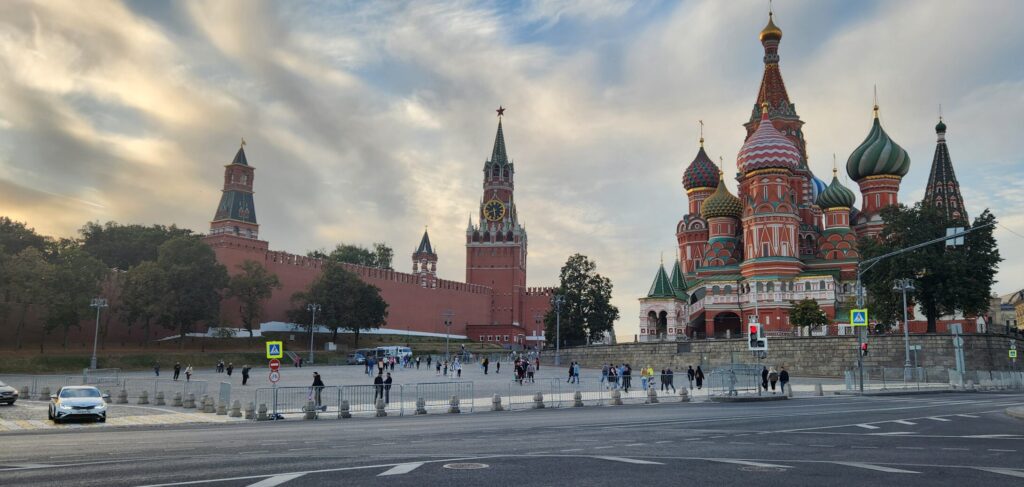
I was surprised to learn that Moscow is the largest city in Europe. Moscow is an ‘oblust’ but also recognised as a federal city and so is Petersburg. The population of Moscow is around 13 million (1.3 crores) against Russia’s total population of 1.46 billion (14.6 crores). Almost 10% of Russian population lives in Moscow. The city looks vibrant as any other developed European city.
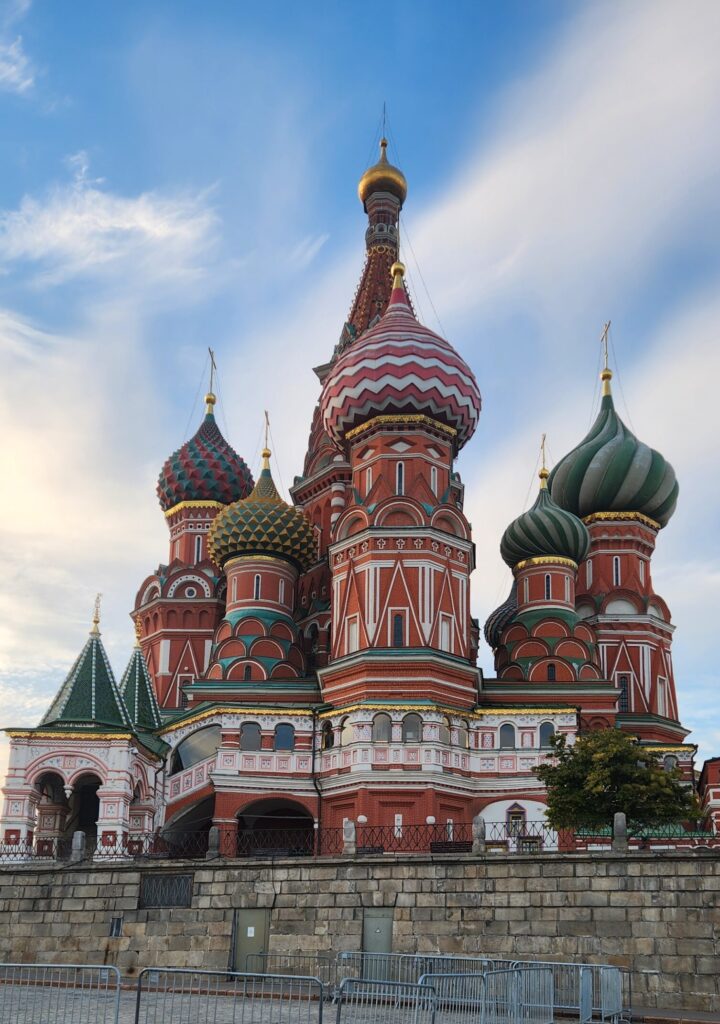
The first destination for any tourist in Moscow invariably is the Red square – the nerve centre of the largest country in the world. And the iconic Saint Basil Church is an eye catcher and a centre of attention in the whole of the Red square complex. Built as an orthodox cathedral by Ivan IV (Ivan the terrible) in the 16th century, the extravagant and bright colored onion shaped domes adds charm to Red square ambience.
Kremlin
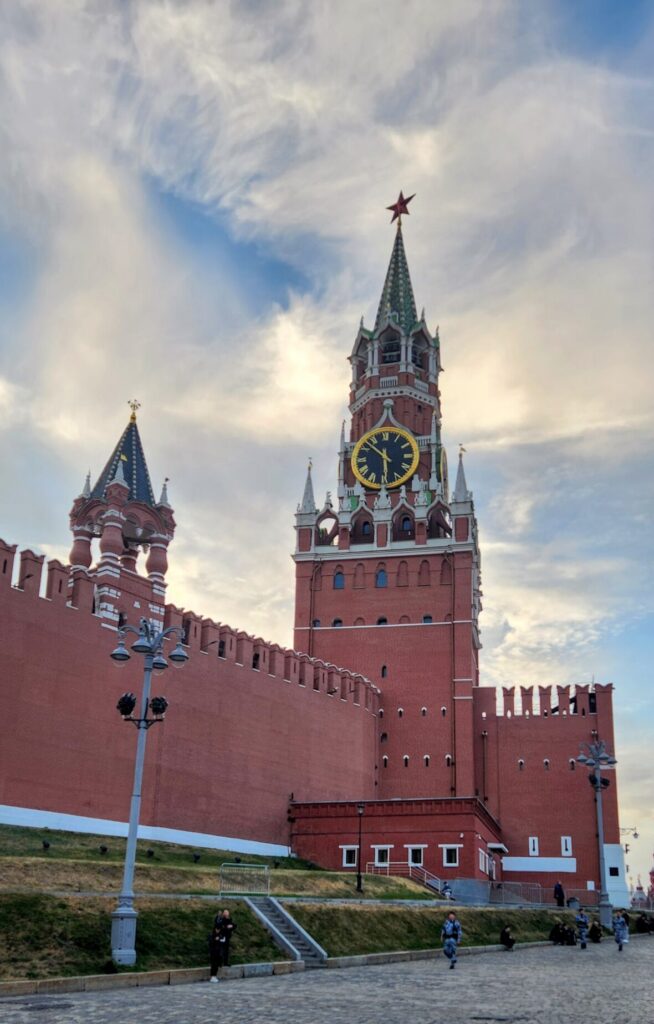
The Spaskya tower was built by Ivan the Great in 1491 and served as the main entrance to Kremlin. The tower is believed to protect Kremlin from negative forces.
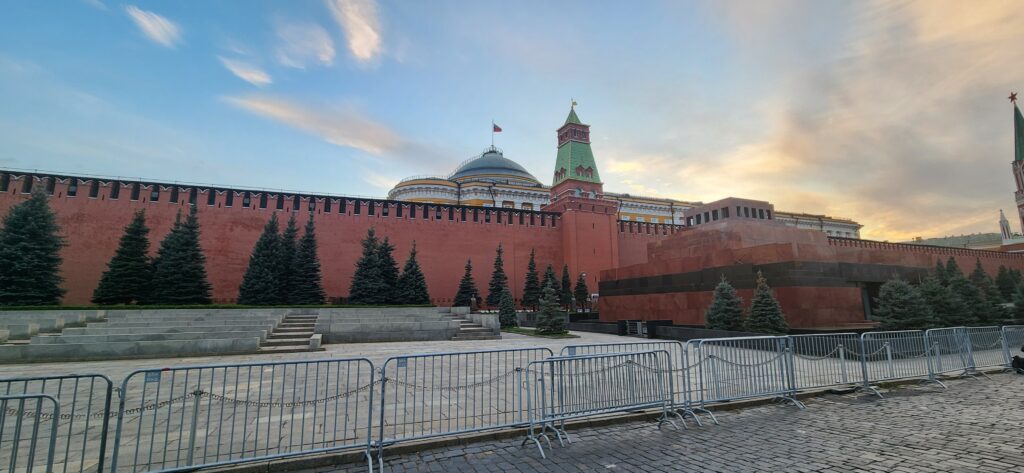
Vladimir Lenin has been laid to rest in the mausoleum in Red Square and the body is preserved for the public to pay respect. The security was rather very tight and photographs were banned inside. Sadly, Lenin and his philosophies dont seem to be popular among the Russians today. The white building partly hiding behind the wall of the Red square complex in the above image is the legislative buildings of Kremlin.
Gum shopping centre
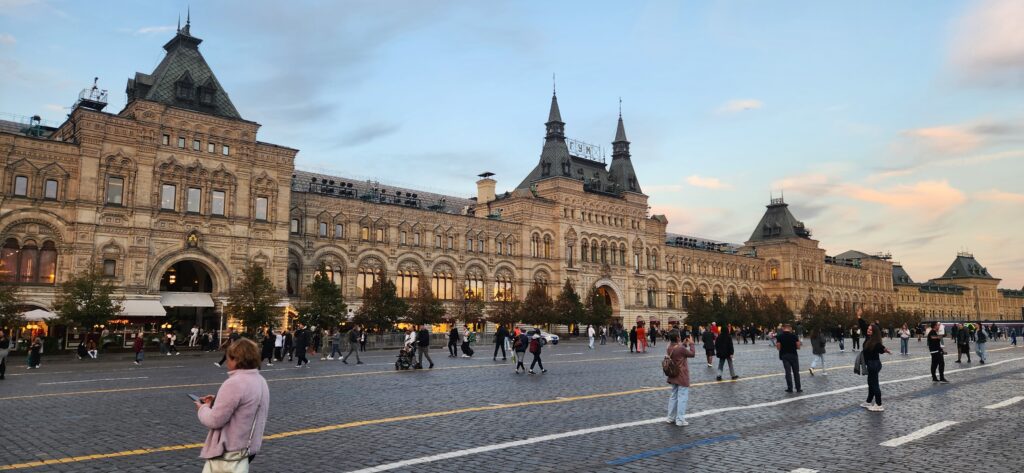
Gum shopping centre on the eastern side of the Red square had undergone many architectural and cosmetic changes over the whole of 19th century but has always remained a trading centre. The present elegant three storey building with 1200 retail trade outlets was constructed by the end of 19th century almost around the same time when the curtains were drawn down on the Romanov dynasty. The primary idea of the shopping centre was to showcase the pride of modern Russia echoing its power of consumerism and progressing economy .
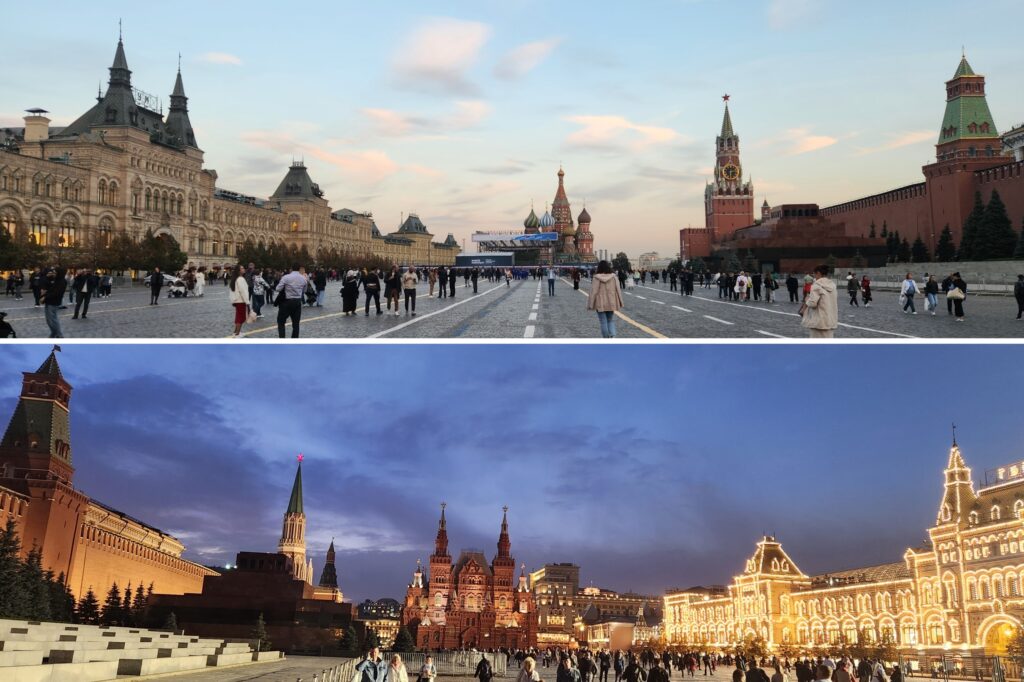
With the advent of Soviet union regime in 1917, the store was nationalised and was named as ‘Gum’ literally meaning ‘State Department Store’ in Russian with the only vendor being the Soviet State. Joseph Stalin even attempted to convert the Gum store into office buildings but failed. After 1991, the store was privatised but still retains its Soviet name. Today, Gum shopping mall is the most extravagant and luxurious mall in Moscow.
Marshal Zukhov statue
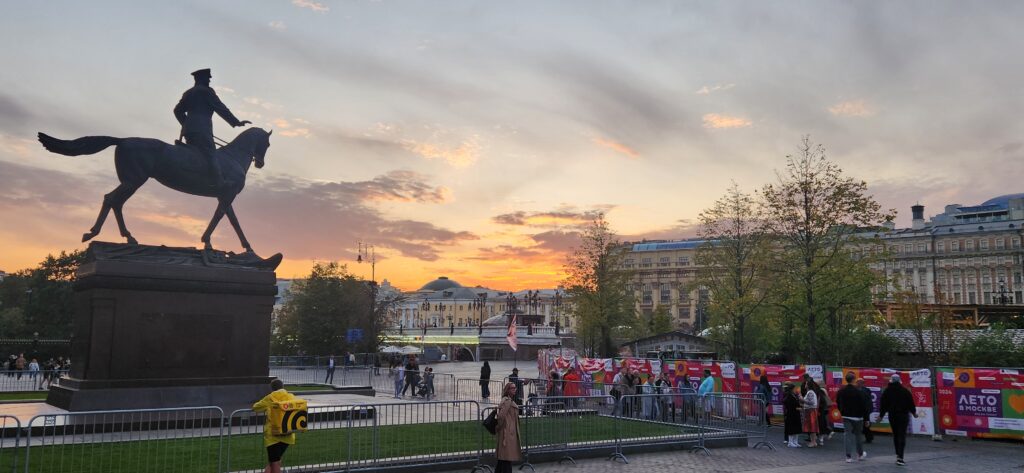
Georji Zhukov was appointed by Stalin as deputy commander-in-chief of the Red army during WW2. Marshal Zhukov defeated German Nazis after a fierceful battle and captured Berlin in 1945. Zhukov’s feat and atomic bombing of Japan simultaneously marked the end of WW2. He commanded the Soviet occupation forces in Germany and even represented the Soviet Union during the victory march in Berlin. Marshal Zhukov became so famous that Stalin decided to demote him. The contribution of this outstanding Russian military commander was finally recognised when the above statue was built in 1995 as a part of commemorating 50yrs of WW2.
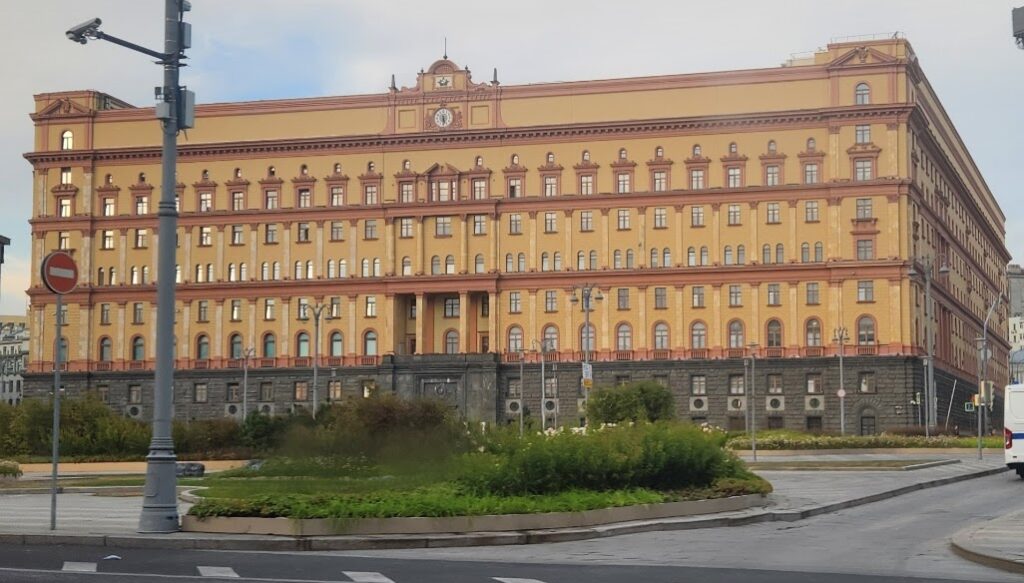
The above image is of an interesting building in Moscow. Any guesses? It’s the KGB headquarters popular in western cinemas reflecting the cold war between yesteryear USSR and US. KGB is Russia’s intelligence / investigative agency like CIA in the US and RAW in India. Many Hollywood movie stories revolved around exposing villainous KGB secret agents spying and targeting US interests. Today, KGB is known as Federal Security Bureau(FDB) after the formation of Russian Federation in 1991.
Day 2-September 25th 2024-Moscow
Tretyakov Gallery
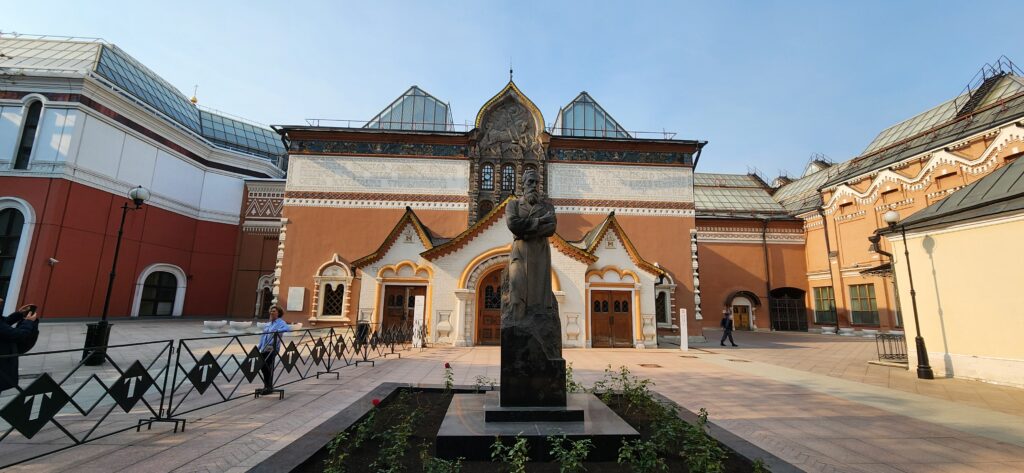
The 2nd day in Moscow began with the visit to State Tretyakov Museum named after Mr.Pavel Tretyakov- a business noble and a private collector of precious Russian paintings. The museum is one of the largest art gallery in the world displaying more than 190,000 Russian arts from the 11th to 20th century including Tretyakov’s exclusive private collection.
Moscow subways

I mean no exageration when I say Moscow subway runs between museums and not metro stations. Yes, Moscow’s 200+ subway stations are draped with rich and unique artisitic work and 44 of them are declared as cultural sites. The first subway was initiated during the tenure of Joseph Stalin in 1935. The metro network expanded over decades but the Soviets never curtailed their zeal in building monumental and artisitic stations. I am curious as to why the communists chose to build such lavish subway stations – probably to divert the people from being religious? Or is it because palatial buildings are meant for all as per Marxist ideologies? Whatever be the reasons, the subway stations are a great experience for any traveller visiting Moscow.
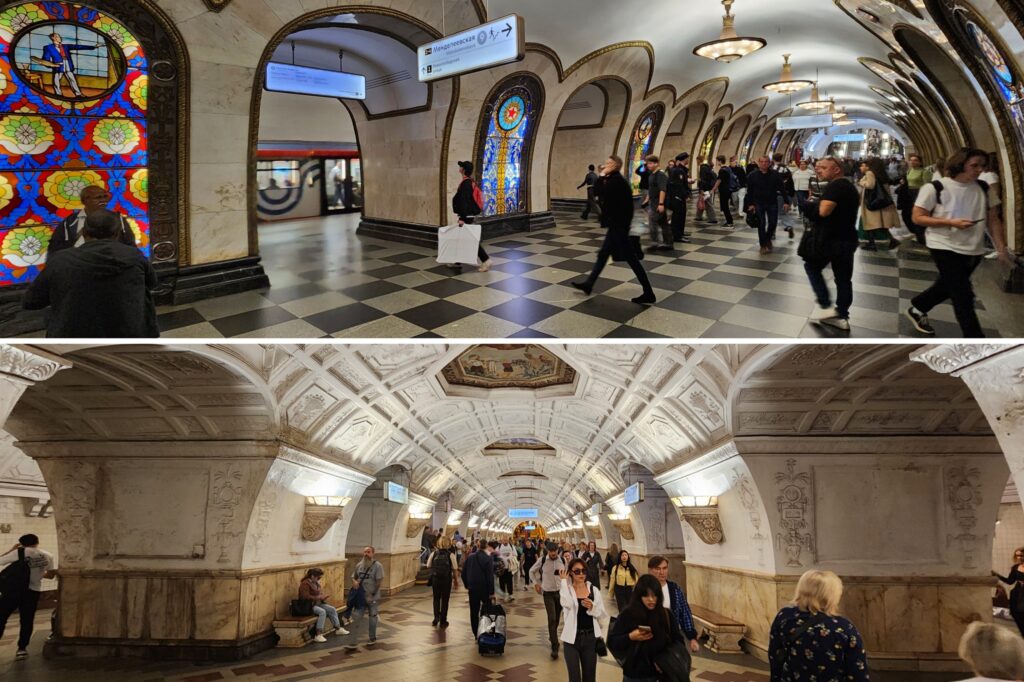
The subway stations were built so strong and deep (typically 35-55metres deep) that people used them as shields from German air strikes during WW II. As they found safe homes in trains parked in the metro stations, many temporary provision shops, saloons and even a library started mushrooming underground to cater to daily essential requirements. Joseph Stalin had even addressed a public gathering on October 21,1941 in Mayakovskaya station to commerate October revolution.
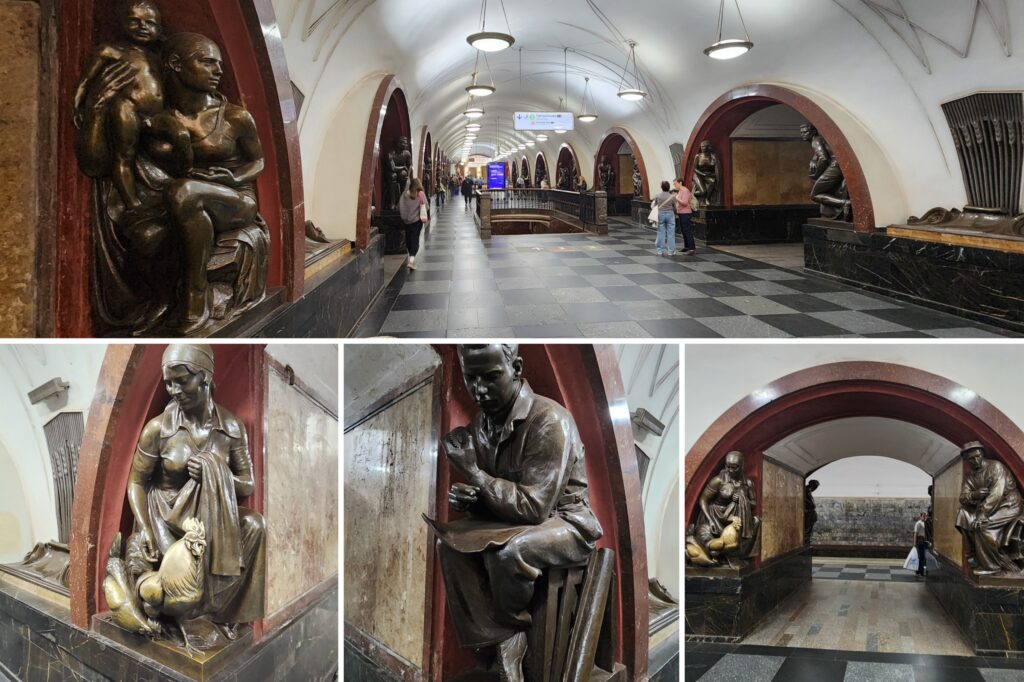
The Ploschad Revolyutsii station is adorned with an array of beautifully crafted bronze statues as seen in the picture above. The floor tiles resembled a chequered chess board. It was amusing to watch the locals rubbing on the bronze statues particularly a dog’s nose and a rooster as part of their popular belief for good fortune.
Another speciality of Moscow Metro is its impressive track record of maximum frequency of trains and punctuality. During peak hours, trains arrive and depart every 90seconds and are 99.99% on time.
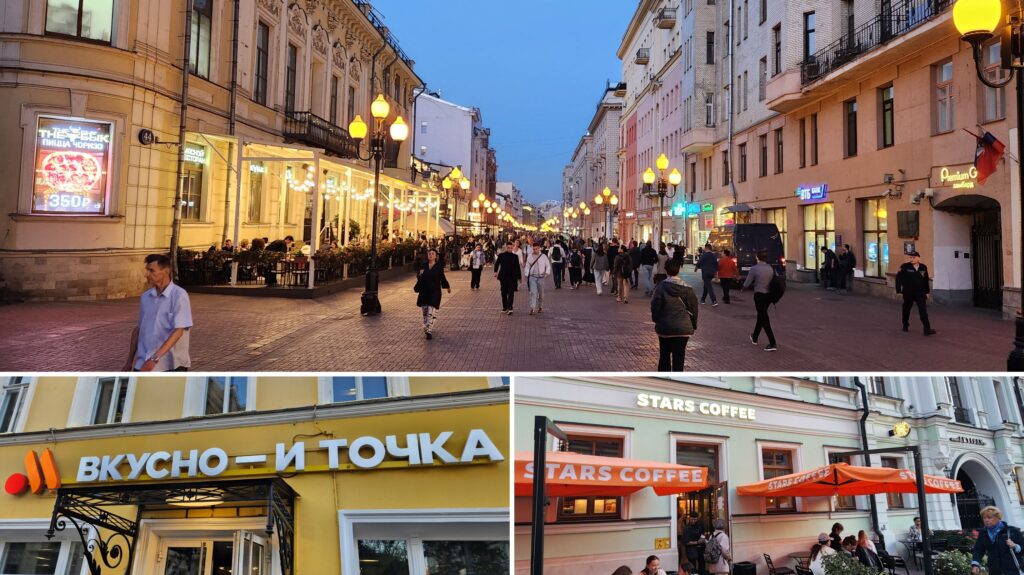
Arbat Street, Moscow’s shopping arcade
We hopped on and off at atleast 5 stations in Moscow Metro before finally reaching Arbatskaya station. Incidentally, Arbatskaya station is the gateway to Arbat street, a throbbing shopping arcade of Moscow. There are restaurants and shops selling souvenirs and garments. We also found McDonald and Starbucks coffee outlets in Arbat street rebranded as ‘Vkusno & Tochkaa’ and ‘Star Coffee’ for Russia.
Day 3-September 26th 2024-Moscow
Cathedral of Christ the Saviour
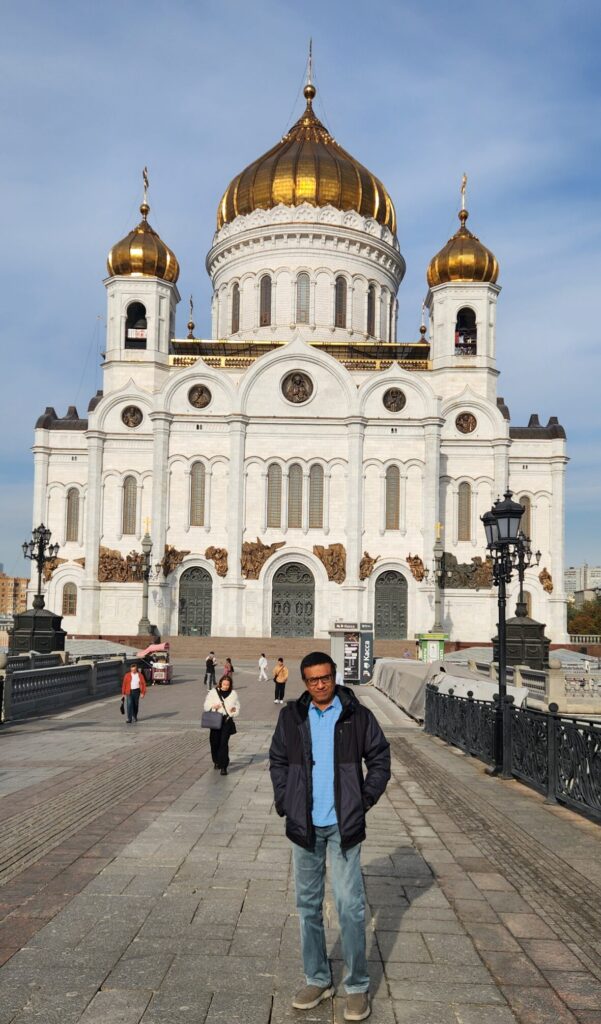
In 1812, when Napolean Bonaparte was defeated and forced to retreat from Moscow, Alexander-I wished to build a cathedral as a symbol of gratification for saving Russia from French invasion. The cathedral was designed similar to Hagia Sophia in Turkey and was built on the banks of River Moskva much later. (please read about Hagia Sophia in my Turkey post) Sadly, the church was demolished in 1931 when the Soviet Politburo wanted to build a legislative palace in the same place. Meanwhile, the beginning of WW2 and the subsequent fall out in economy hindered the Soviets’ plans. Only in year 2000, the cathedral seen in the photo above was rebuilt with generous contributions from the Muscovites. Cathedral of Christ the Saviour is the 3rd largest among Orthodox Christian churches in the world.
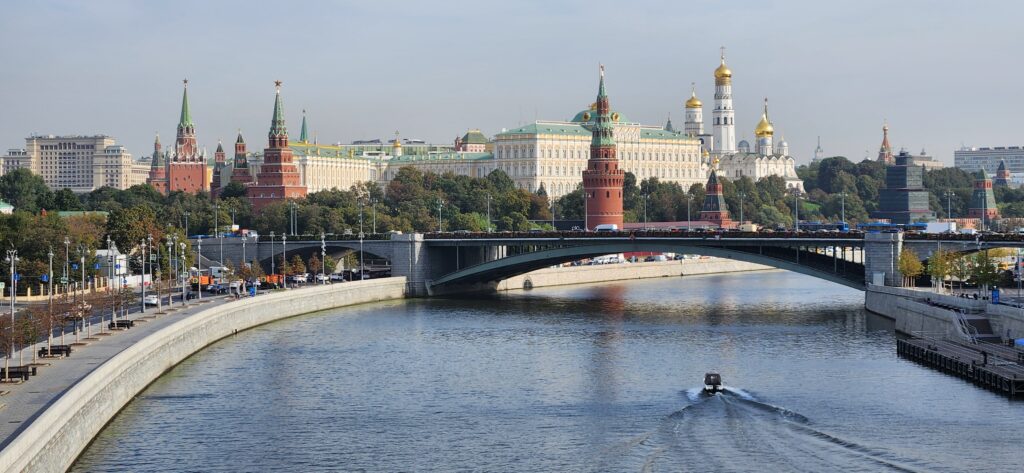
I have been frequently mentioning about Orthodox Christians when I speak about Russian Christianity. For those who are equally curious like me to know who these orthodox christians are, please read ahead.
A short note on Orthodox Christians
There were brewings divisions over centuries among Christians in the western and eastern Europe over the doctrinal differences, Rome’s papal domination and growing socio political differences. When the western Roman empire gradually fell, the Byzantine empire (eastern Roman empire) continued to flourish with Constatinople (today’s Istanbul) as capital. With conflict at its peak, Patriach of Constantinople (head of East Roman Christians) was expelled from the Roman Church in 1054CE and this episode sparked the split of Christianity into Roman Catholic and Eastern Orthodox Christianity. As mentioned earlier, Kiev’s Russia was influenced by the Byzantines owing to their close proximity and thus adapted Orthodox Christianity around 10th century CE. Today, 63% of Russians are Orthodox Christians and 26% follow no religion and 7% are muslims.
There could be innumorous differences followed in Roman Catholic and Orthodox Christian churches. I am quoting a few based on my own observations and from what I learnt from my local Russian guide.
- The head of Orthodox Christians are Patriachs and not Vatican Pope.
- Both believe in Trinity – The Father, the Son and the Holy spirit but Roman Catholics believe the Holy spirit flows from the Father to Jesus(the son) and Orthodox christians believe that the holy spirit flows only from the Father.
- Christmas for Orthodox Christians is on 7th January as they still follow the Julian calender for religious purposes.
- There are no pews (wooden benches) to sit and pray as we usually find in the Roman catholic churches but instead there are a few benches along the walls of the cathedral.
- The men are expected to remove their hats/head gears/caps but women need to cover their scalp.
- The traditional organ (instrument) seen in all RC churches are missing here.
- The interiors are adorned with glittering gold and stones and priests sport a beard.
1st journey in iconic Trans Siberian railways
Having read about the Orthodox Christians, now its time to get back to the highlight of the whole tour and thats the 1st Trans Siberian train journey from Moscow to Ekaterinburg.
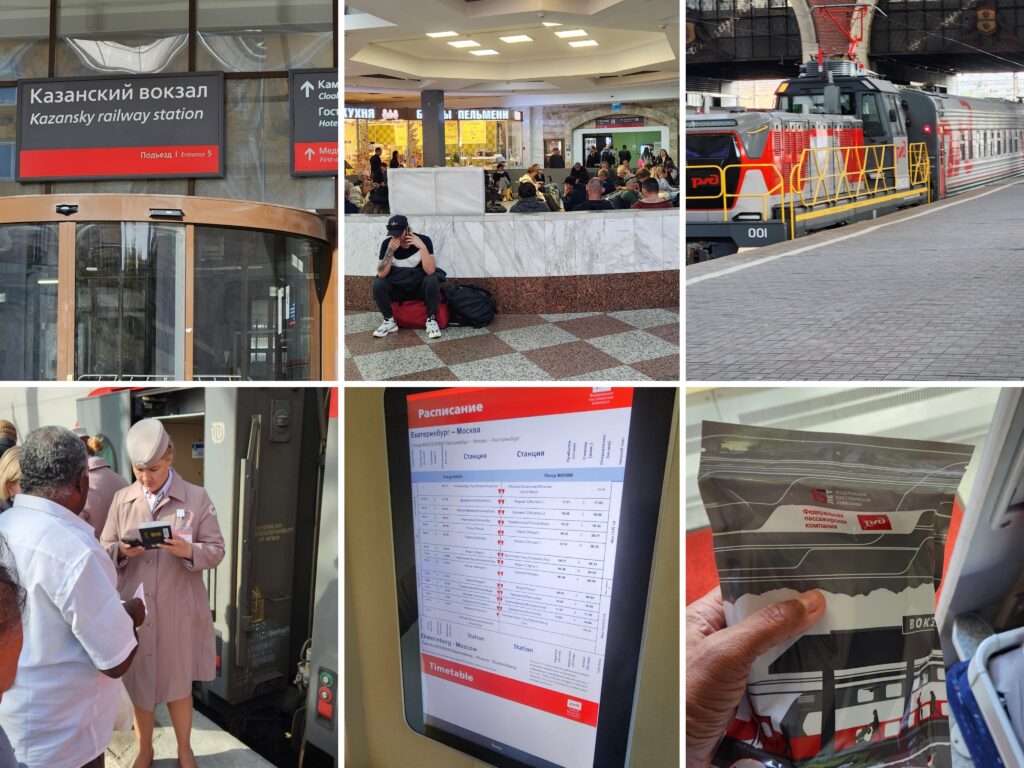
After an early lunch in an Indian restaurant (Khajuraho), it was time to bid goodbye to the charming capital city of Russia. We were filled with curiousity and anxiety as we walked into Kazensky railway station in Moscow to board the world’s most iconic train. The wagon attenders standing right at the wagon entry checked our passports and tickets before letting us in. And as the train started moving we began to settle down slowly adapting to the new environment. The distance between Moscow and Ekaterinburg is 1700kms and the train was scheduled to reach Ekaterinburg next day evening. Now, let me utilise this time to share with you complete information of Trans Siberian Railways network.
A short note on Trans Siberian Railways
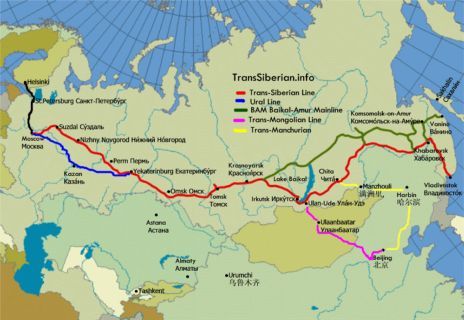
Route map of Trans-Siberian Railways
Trans Siberian railway is the longest train route in the world connecting Euro-Russia in the east to Pacific coast in the west (9289kms). The project was initiated by Alexander-III and the actual construction began in 1891 and was completed in 1916. It was primarily used to transport soldiers and military logistics during WW-1/WW2 and during civil war that broke out in 1917 immediately after the power shift to communist regime.
Despite its abundant mineral content, Siberia remained a neglected zone owing to its harsh cold temperatures. The advent of Trans Siberian railway unfolded many avenues of exploration and industrialisation transforming Siberia into a major contributor to Russian economy. The train route from Moscow passes through major Russian cities namely Kazen, Ekaterinburg, Omsk, Novosibirsk, Irkutsk, Ulan Ude, Chita and Khabarovsk before reaching Vladivostok (on the shores of Pacific Ocean,close to Japan). ‘Rossiya’, the daily train that runs between Moscow and Vladivostok and vice versa takes 7days one way and poses a challenge to our biological clock crossing over 8 time zones (Russia has 11 time zones)
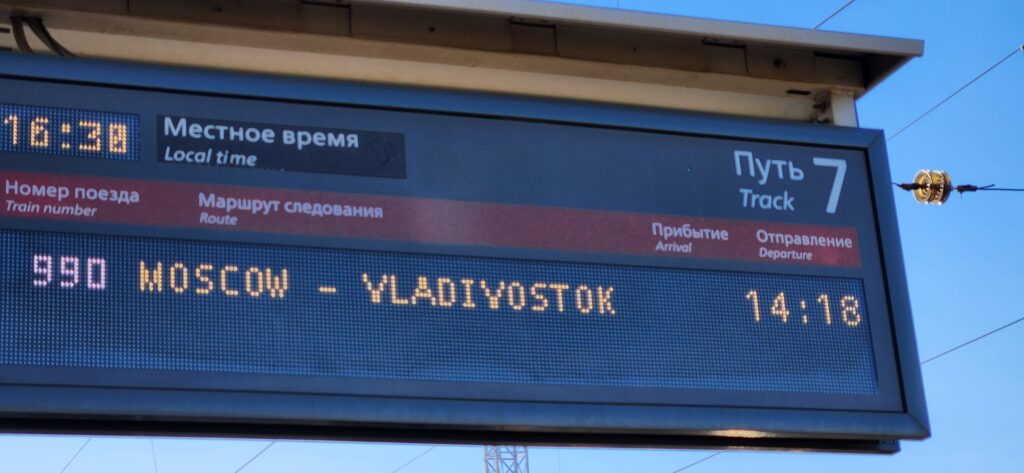
Trans Mongolian railway technically connects Moscow and Beijing, China (7621kms) via Mongolia. This ambitious project involves 3 countries namely Russia, Mongolia and China and follows the same route as Trans Siberian train for 5488kms starting from Moscow until Ulan Ude. Here, the train deviates and turns south to enter Mongolian border and reach Ulaan Baatar, the capital of Mongolia. The journey continues through the Mongolian Gobi desert until the Chinese border in Erlan (Erlyan or Erlian) where the train’s roller stocks are replaced to adapt to Chinese railway network. This interesting rail engineering adaption takes a few hours and meanwhile the passengers complete immigration formalities.The sector on the Chinese territory is operated by the Chinese train services until the train reaches Beijing, the final destination. Trans Mongolian railways is suspended since Covid and havent resumed till now. The services between Russia and Mongolia were also discontinued recently for a brief time owing to Russia/Ukraine war but has resumed now.
Trans Manchurian railways connects Moscow and Beijing through the Manchurian part of China(via Harbin, famous for its winter ice festival) to reach Beijing (8961kms) thus bypassing Mongolia. This route was preferred by passengers with no valid Mongolian visa. Like Trans Mongolian railways this service also remains suspended now.
- Moscow city has 9 train stations connecting Moscow to all major cities in Russia.
- Trans Siberian trains are not high speed trains. The speed is around 90 to 100kms/hr similar to Indian trains (high speed trains run only on the Moscow-St.Petersburg and Helsinki(Finland)-St.Petersburg routes)
- Russians use trains extensively in the Trans Siberian route and it was full almost everytime we travelled.
- 1st class cubicle has 2 sleeper berths, 2nd class cubicle has 4 berths and 3rd class has no cubicles (similar to open cubicles in Indian trains). We always travelled in the 2nd class.
- Clean linen, pillows, slippers and toilet kits were provided in the 2nd class.
- Every wagon has a hot and cold water outlet on one end and 2 toilets/1 shower on the other end.
- There is one attender exclusive for each wagon to assist the passengers. I have written in detail about their role later in the blog.
- There is a full fleged pantry car with a restaurant serving Russian food. Food is also served in our seats when pre-booked.
- 4 lockers are provided in each cubicle to keep valuables like passports/mobiles/wallets safe.
- Mobile network works only when the train gets closer to major stations (roughly 70-80% of the travel time you would remain disconnected).
Day 4-September 27th 2024-Train Travel
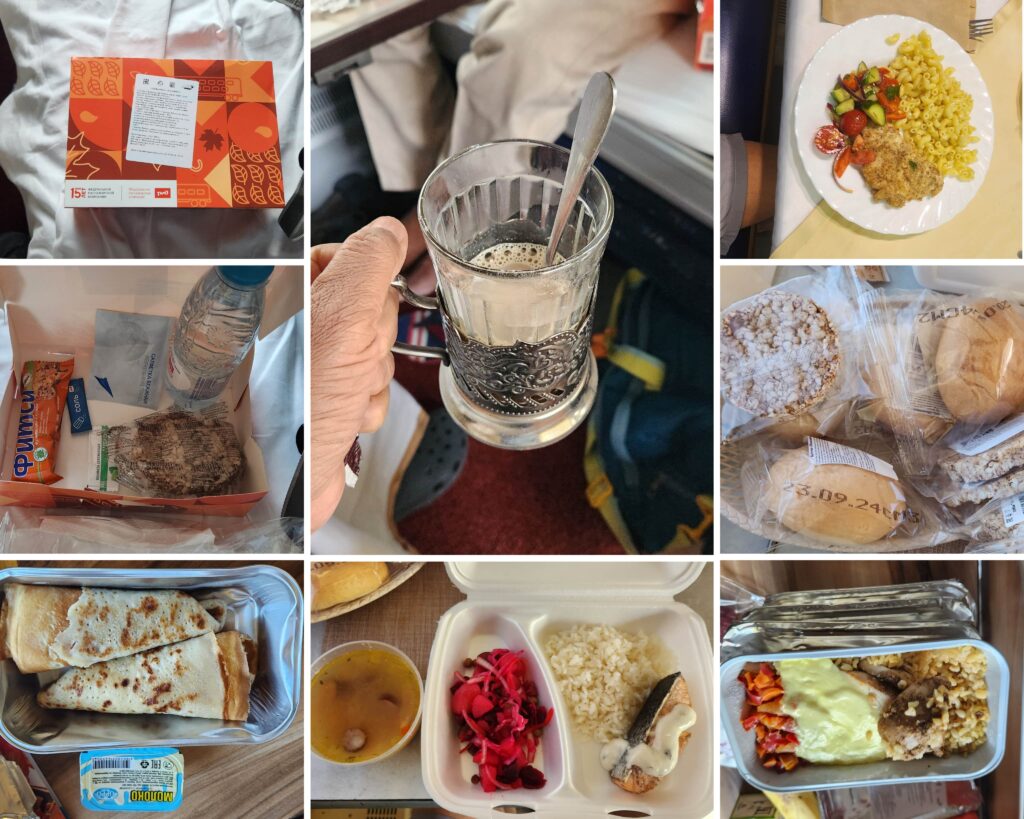
We woke up to the sound of a hyperactive school group kids running and giggling around the wagon lobbies. One senior teacher accompanying the chidren fortunately spoke English.They had boarded the train at Kazan (hope you remember this city when I told you about the visit of PM Mr.Modi recently) around midnight and were returning to Ekaterinburg after attending a gymnastic event. The teacher showed me a pack of hula loop rings and proudly introduced a few kids who had won trophies in the sports meet. The kids were friendly but we could only interact with them in sign language. We offered them Indian biscuits and cookies and they were so delighted.
We reached Ekaterinburg as per schedule and checked in at the hotel spending rest of the evening relaxing after the long journey.
Day 5-September 28th 2024-Ekaterinburg
A short note on Ekaterinburg
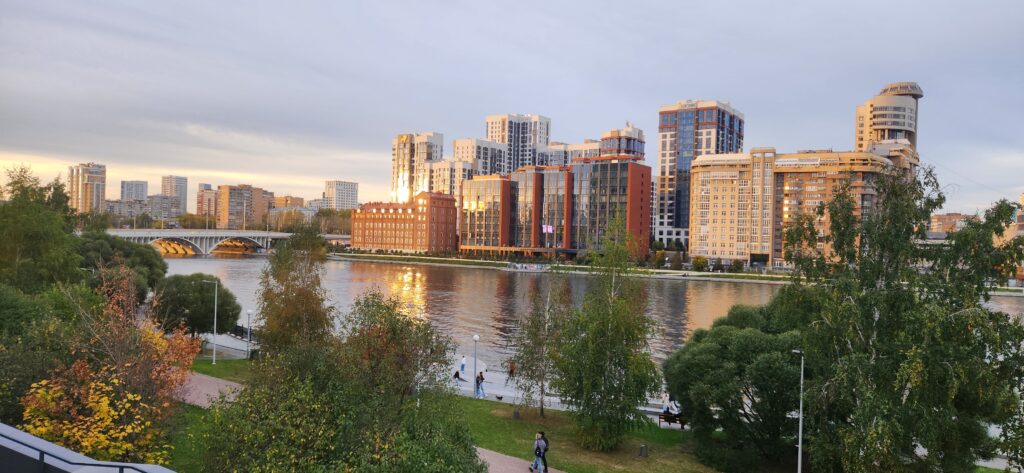
Ekaterinburg is the capital of Sverslovsk Oblast lying between the Ural mountains/Volga river and Siberia. Its exactly at the cross roads of Europe and Asia and has picked its name from the orthodox name of Catherine I (wife of Peter the Great). Ekaterinburg is the 4th largest city in Russia (next to Moscow, St.Petersburg and Novosibirsk) with a population of 1.5million (15lakhs). Ekaterinberg’s rich mineral wealth steered the city towards a remarkable industrial growth with many metal, timber, pulp and paper industries thriving around the city. The abundant natural resources of Sverslovsk Oblast contributes substantially to growing Russian economy. Thanks to the industrial boom – the city grew into a reputed centre for higher education and research catering to its demand for skilled workforces.
Ekaterinburg is also home to military establishments including the headquarters of Central Military district of Russian Armed forces.
Sad story of the last Romanov family
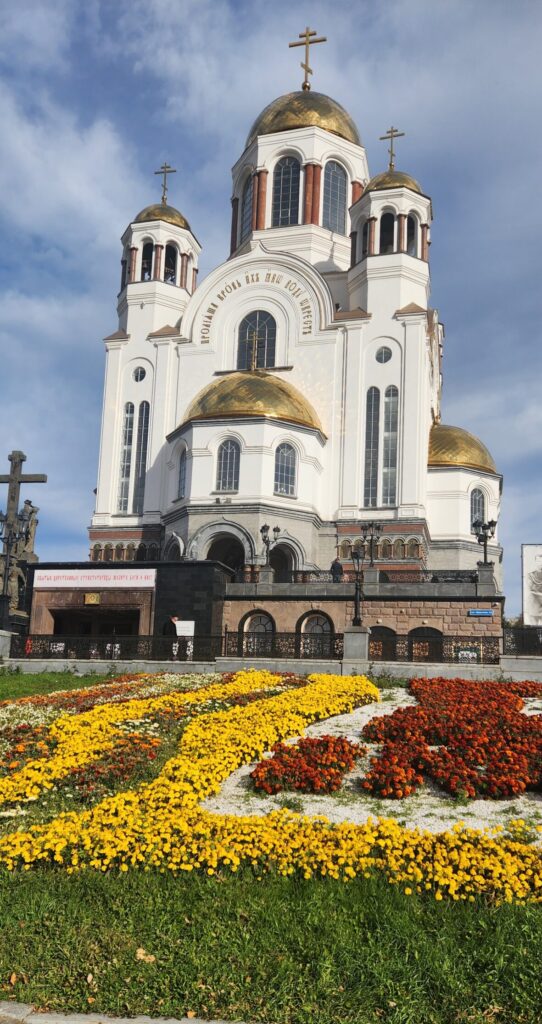
Nicholas-II, the Tsar of Russia was forced to abdicate his throne when the Bolsheviks led by Vladimir Lenin seized power after the October Revolution in 1917. Nicholas-II and his family were held as hostages in a posh mansion in Ekaterinburg. When civil war broke out in 1918, the anti-Bolshevik ‘white army’ overpowered the Bolsheviks and marched towards Ekaterinburg in an attempt to restore the royal family. Panicked by their advancement, the Bolsheviks decided to eliminate Nicholas-II and his family locked in the Ekaterinburg mansion. On the late night of July 16th, 1918, Nicholas-II, his wife Alexandra, their 4 daughters Olga, Tatiana, Maria, Anastasia and 13yrs old son Alexei along with their 4 servants including their family doctor were asked to decend to the mansion’s basement on the pretext of a photo-shoot. Unaware of the plot, the royal family reached the basement only to encounter an execution squad shooting at them point blank and stabbing them with bayonets as some were believed to be wearing bullet proof vests.
The dramatic version of this whole royal massacre episode is the miraculous escape and survival of the last daughter Princess Anastasia. Imposters had surfaced on many occasions claiming to be Princess Anastasia – the closest and most interesting being a German/Polish woman called Anna Anderson. These fairy tale stories of Princess Anastasia never failed to enthuse the entertainment industry as many dramas and movies were produced based on the rumours of the great escape and survival of Anastasia (check the 1956 American movie Anastasia)
Now getting back to Ekaterinburg, the infamous mansion was demolished by the Soviets leaving the cellar intact for unknown reasons. The present church was built in year 2000 exactly above the cellar and stands to narrate the horrific stories of the brutal massacre. The exact spot of massacre in the cellar has turned more sacred with people offering their prayers here.
Ganini Yama- Memorial for the Nicholas-II family

The Bolsheviks are believed to have concealed the corpses of the massacred royal family in a mine-shaft 15 kms away from the city (today’s Ganini Yama monastry) but later transferred the bodies 4kms deeper into the forest for the fear of being found. It was only after the fall of Soviets in 1991, the mutilated bodies of the Royal family of Nicholus-II were recovered (except the ones of the last daughter Anastasia and son Alexai) and subsequently buried in St.Peter and Paul Cathedral in Petersburg, the traditional resting place of Romanov family starting from Peter the Great.
Nicholas-II has been confered with sainthood by the Russian Orthodox church. Ganini Yama monastry with seven wooden chappels dedicated to the seven members of the Nicholas family was established in year 2000 in tandem with The Church on Blood in Honour. As we walked around the huge monastry, the deep tranquility added to a feel of sadness reverberating from the forest, trees, plants, flowers and the wooden chapels in the monastry. Ganini Yama resonates a grim memory of the most gruesome murder in Russian history.
The continental divide
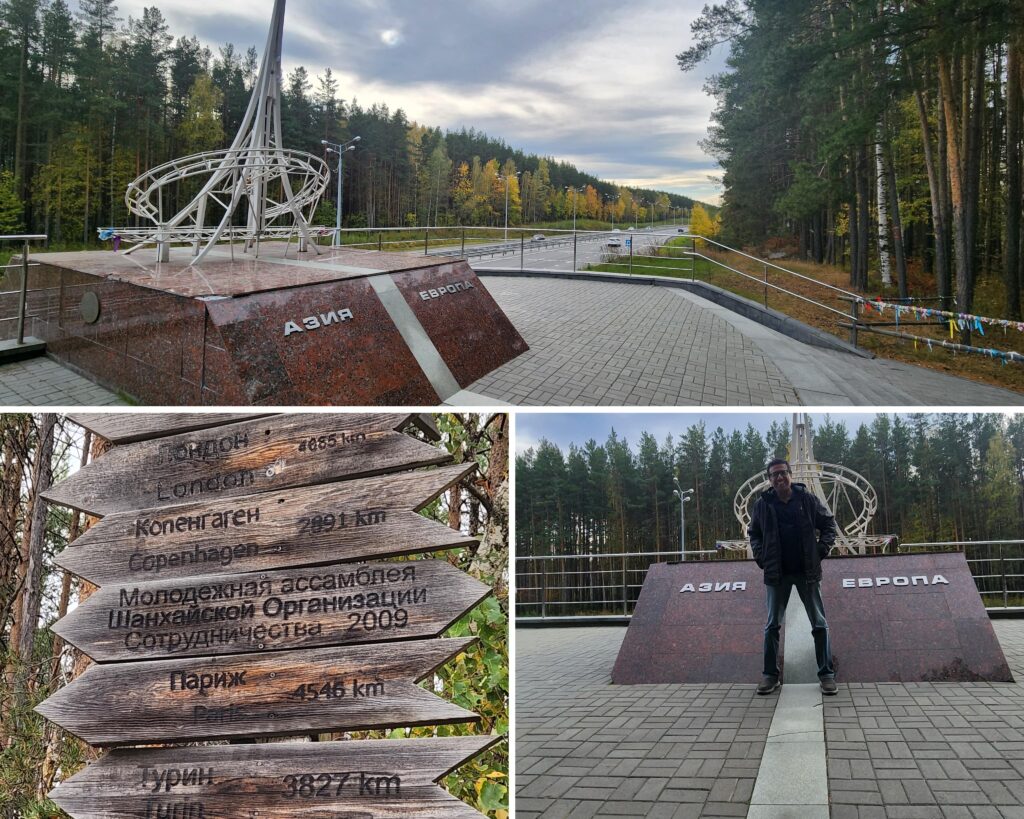
The exact continental divide between the European and Asian Russia lies 35kms west of Ekaterinburg right on Moscow-Ekaterinburg highway. The demarcation point has transformed into a touristy place perfectly apt for a photo session with a ritual pose standing with each leg in one continent (as you see me in the image above).
Prominent buildings in Ekaterinburg
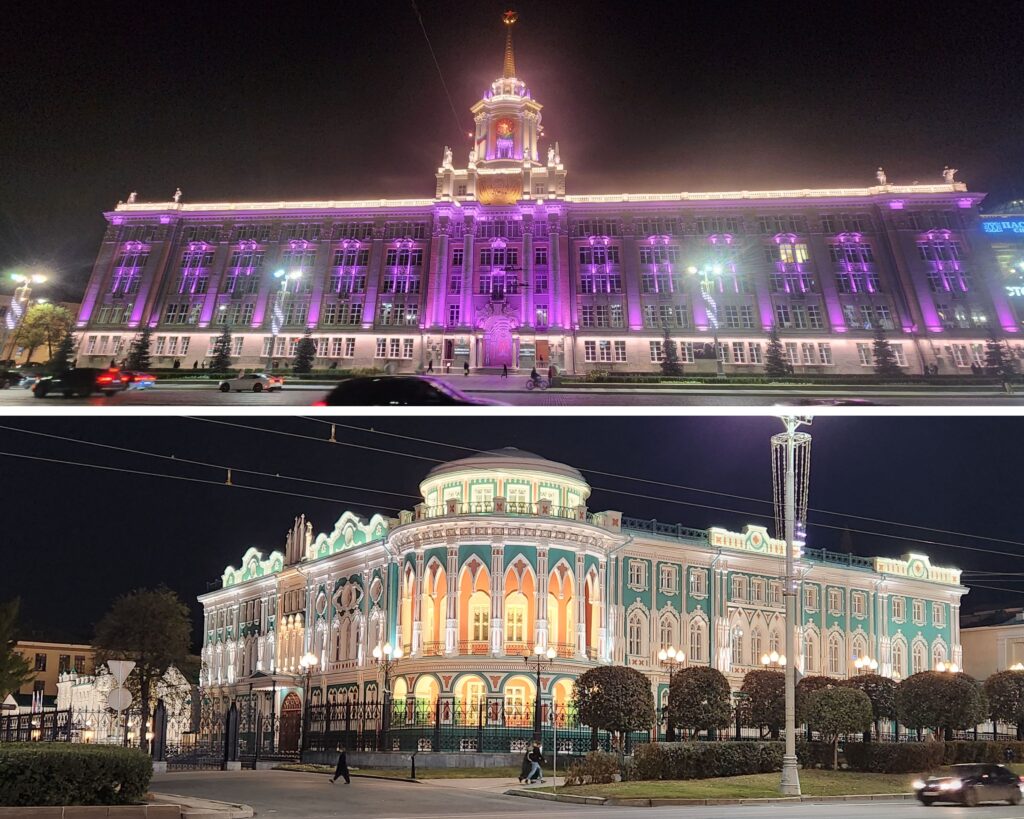
Ekaterinburg is adorned with many beautiful buildings designed with a flair of Euro-Russian architecture. The city hall and the Sevastyanov house looked very impressive especially when lit in the night. Sevastyanov House was built by a clerk in making a big fortune in the mining department and then apparently sold to the State. Some say even the Russian Presidents stay here while visiting Ekaterinburg and not much is known to public as entry is prohibited. The lake on the Iset river and the adjoining park and skyline with occasionally popping skyscrappers is a spectacular sight.
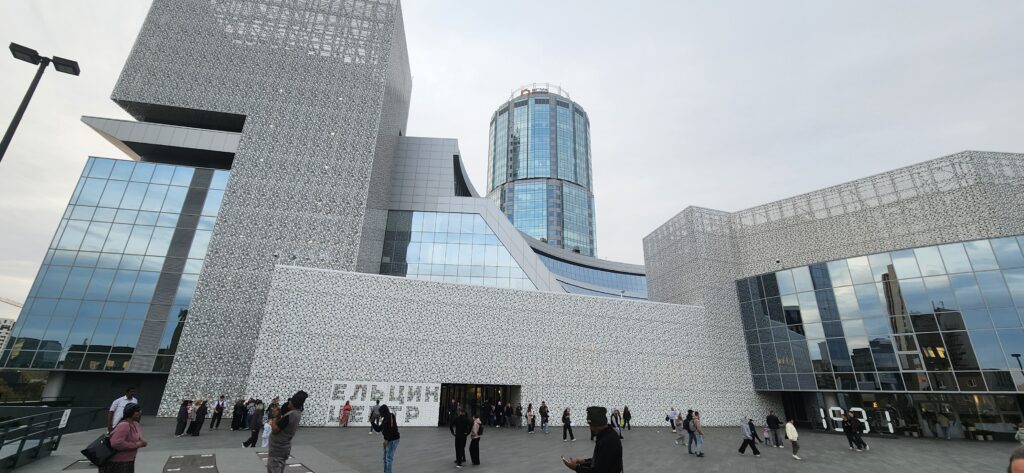
Ekaterinburg is the home town of Boris Yeltsin, the first President of Federal Russia after the dissolution of Soviet Union in 1991. The Boris Yeltsin Presidential centre or simply Yeltsin Centre was inaugurated in 2015 by the present Premier of Russia, Vladimir Putin. It was Boris Yeltsin who chose Vladimir Putin to lead Russia when he retired from presidentship due to illness.
Dusk had set in by the time we visited the Yeltsin centre and walked along the banks of Iset river. And now, we had to pack our bags and get back to railway station to board our 2nd leg of train journey from Ekaterinburg to Krasnoyarsk. The train originating from Moscow was scheduled to reach Ekaterinburg around 9.30 in the night. This time we were a little more seasoned with Russian trains and were looking forward to the longest leg of our tour and boarded the train after completing all formalities (36hours journey and 1963kms) .
Day 6-September 28th 2024- Train Travel
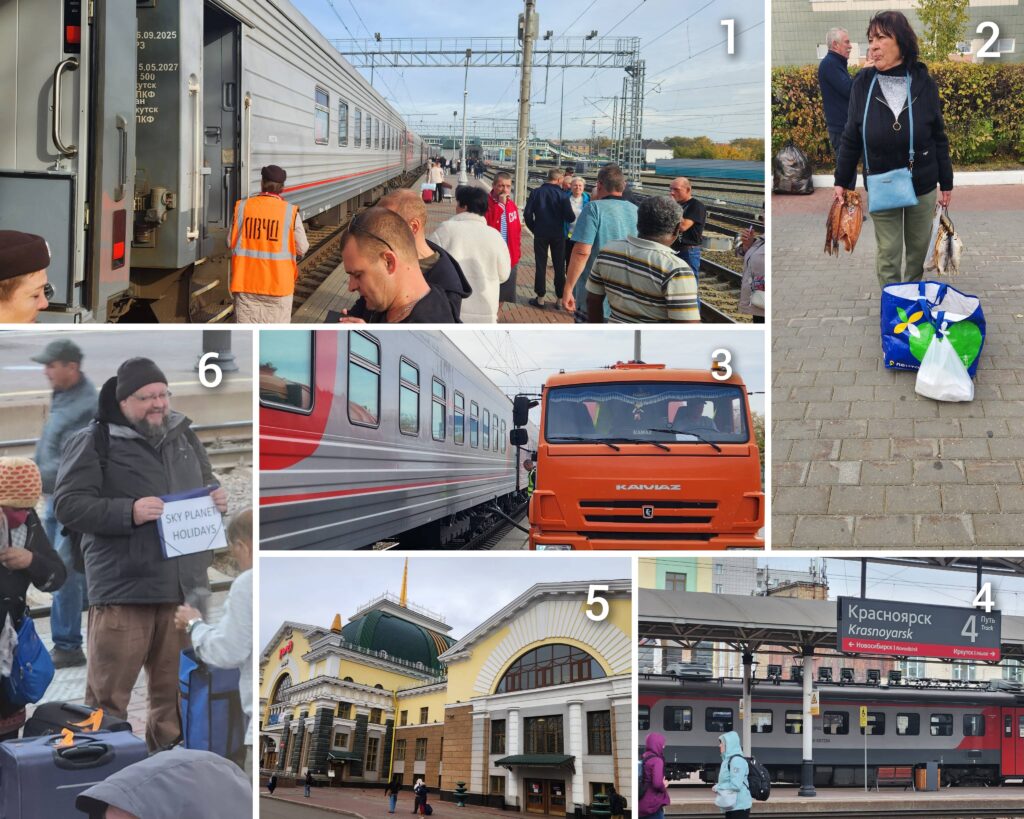
The whole day was spent travelling and now its time for a kind of a disclaimer about what exactly one would see through the windows while travelling in the Trans Siberian train route. You are mistaken if you expect to see misty tall mountains, silver waterfalls, blue lakes, small beautiful towns and wild life like deers, polar bears and Siberian tigers and what not. Ironically, it was rather a monotonous view of flat swamp grassland with scattered trees, thick in some areas and literally nothing more stretching thousands of miles. Siberia is predominantly characterised by Taiga or snow forest with coniferous trees such as pine and birch and a few desiduous trees mainly larch. Taiga is the largest biome (having the same physical characteristics) in the world occupying 11.5% of earth surface and Siberia has two-third of world’s Taiga forest. And coming to Siberian tiger, this is more a myth as there are no tigers living in Siberia. Tigers are found in the Amur region of south-east Siberia and Northern China. The Amur tigers are highly endangered with just 400 surviving.
Since we were fairly large group of 13 members, we managed to entertain ourselves but if you are a smaller group or a solo traveller then be prepared for an extremely mundane experience. I picked up a conversation with co-passenger, a middle aged woman named Anna who was friendly and somewhat fluent in English. In the evening when the train reached Novosibirskv (3rd largest city in Russia) another young Russian girl occupied the vacant berth in my coupe. She was heading back home in Irkutsk after a solo trip to Mongolian border. She was very fluent in English and introduced herself as Julia, a tele-communication engineer. I had a good interaction with her as I got to know more about Russian culture and lifestyles. It seems they learn English in Russian schools but don’t practise the language as there is no neccessity. She also mentioned about the pain of 11 different time zones and how Moscow’s bureaucracy expects to align everyone’s working times with theirs. At this point let me share some of my own observations about Russia and Russians in general.
- Russians are a little stern, not so friendly and usually don’t respond to smiling gestures. I got the first real feel of them when we were locked in immigration at Moscow Domodedovo airport.
- Russians still feel intimidated to speak openly about Russian politics. One of our guide was too reluctant to discuss about the democratic process in Russia and another guide commented discreetly that investigative agencies in Russia still have eyes and ears everywhere.
- I hadn’t seen a single Indian (to be more precise subcontinenten) in Russia in my whole trip….not even in the couple of Indian restaurants that we went (except the restaurant owners😇😇). When US and Europe requires thousands of imported IT skills, I am astonished how Russia has managed with an equally demanding banking, financial and services industry. Russians could accomplish all their requirements as they are workaholic like their Asian counterparts.
- Life for outsiders could be really challenging and a little difficult to survive as everything is in Russian. The people are helpful but language always remains a major barrier.
- I was able to read Russian 60 to 70% in week’s time. The Cyrillic script is easier to read with some practice but to understand and speak Russian would take months or years.
- Smoking is a very a common habit and an integral part of Russian culture. When train approaches any intermediate station, it is the smokers who line up in haste to get down and quickly engulf the platform with strong cigarette fumes.
- I haven’t seen any begging or homeless people in Russia. Not even one…no where. Could that be a positive marker of 75years of Soviet communism? Its highly debatable and I leave the thoughts to you.
Day 7-September 29th 2024-Krasnoyarsk
We arrived at Krasnoyarsk early in the morning around 6 and were welcomed by a classic Siberian autumn weather. For the first time, we were compelled to grab our winter clothes. We quickly checked in at the hotel and got refreshed before we started our exploration of this beautiful Siberian city.
Krasnoyarsk- A brief note
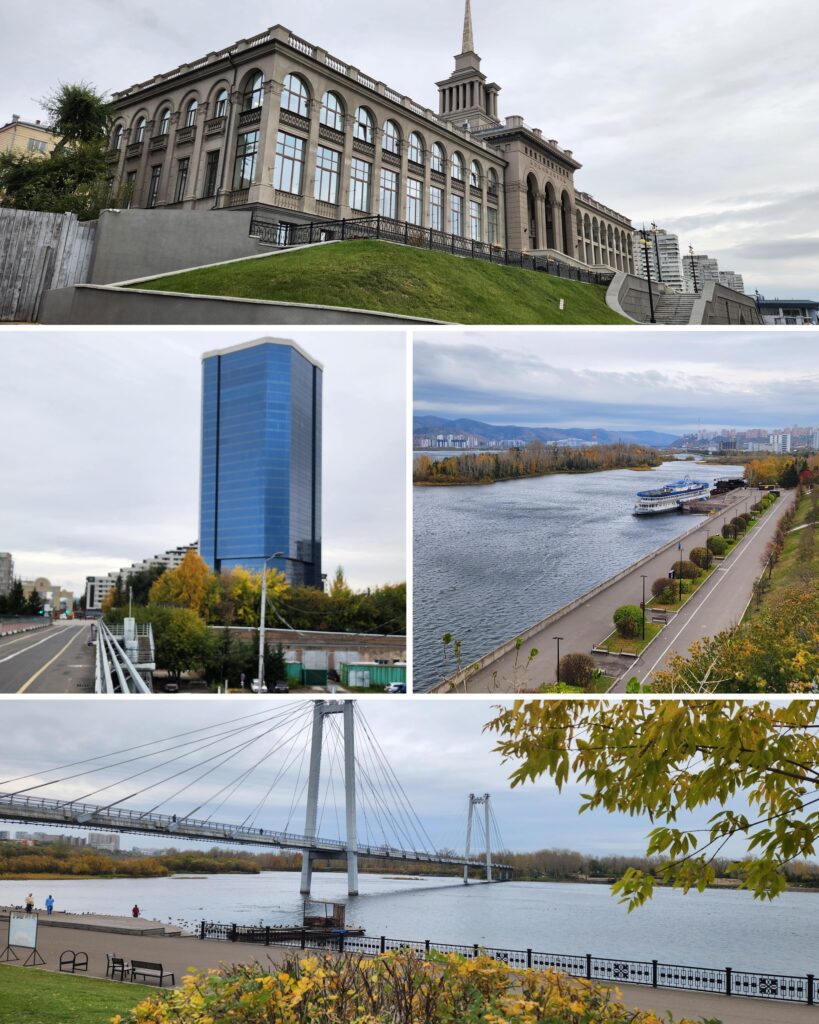
Krasnoyarsk is the largest city in Krasnoyarsk Krai on the banks of Yenisey river. Krasnoyarsk is the 2nd largest and most beautiful city in Siberia with a population of around 1million (10lakhs). Yenisey is the longest river in Russia and the fifth longest river system in the world. It originates from Mongolia in the south and flows north through the Siberian Taiga forests before joining the Artic sea.
Krasnoyarsk has abundant presence of alluminium and the construction of Tran Siberian rail route transformed this city into a major industrial hub. Earlier in the 16th century, Krasnoyarsk was merged with the Russian empire by the Russian cossaks (Ukraine military group) as part of their mission in colonizing Siberia.
Monument of Tsar Fish

Victor Astafyev is a renowned Soviet writer born and brought up in Krasnoyarsk Krai and lived in Krasnoyarsk until his death in 2001. He was honoured with Hero of Socialist labour, a distinguished award of the USSR for his outstanding literature works. The monument was built in Sliznevsky cliff in memory of one of his famous writing, the Tsar-Fish. An observation deck close to the monument opens up to a mesmerising view of Yenisey river and the surrounding mountains. We can also see the birthplace of Victor Astafyev, a small hamlet called Ovysyanka on the bank of Yenisey river.
Krasnoyarsk Dam
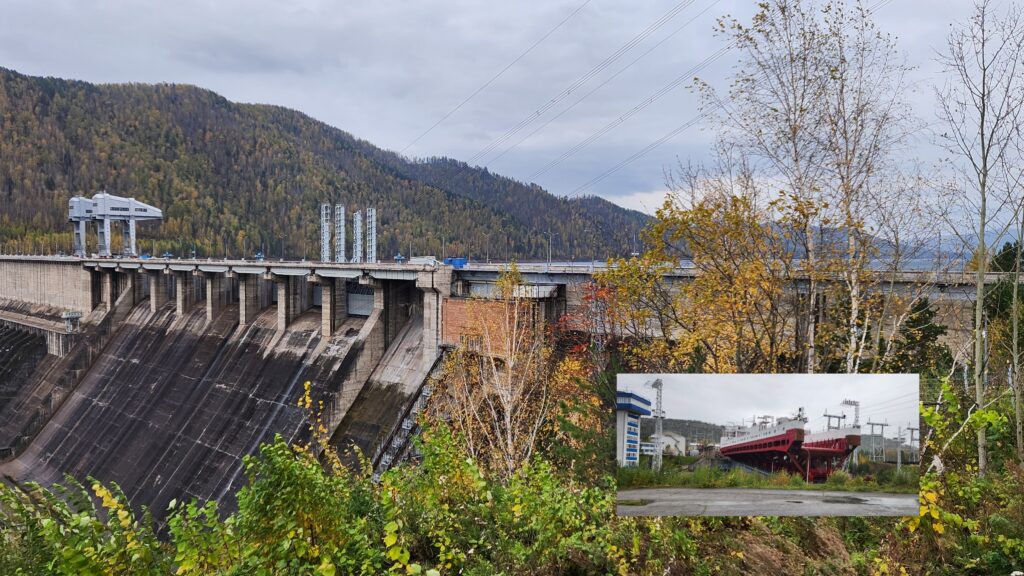
Krasnoyarsk dam is 30kms from the city built across the Yenisay river and generates 6000MW of hydel power. It was inaugurated in 1971 and remained the single largest power plant in the world for 12 years and later lost its position after bigger hydel power projects were commissioned in the US and China. Nevertheless, the hydel project still remains as a great boon supplying power to the aluminium and allied industries around Krasnoyarsk.
Once the dam was constructed, the movement of ships along the Yenisay river came to a grinding halt. The Russian engineers had to devise a special engineering arrangement comprising a turntable to change the orientation of ships and an electric rail to carry ships and set it afloat on the other side of the reservoir. When we visited, we saw the turntable in operation but did not see any actual ship lifting.
Day 8-September 30th 2024-Krasnoyarsk
Karaulnaya Mountains
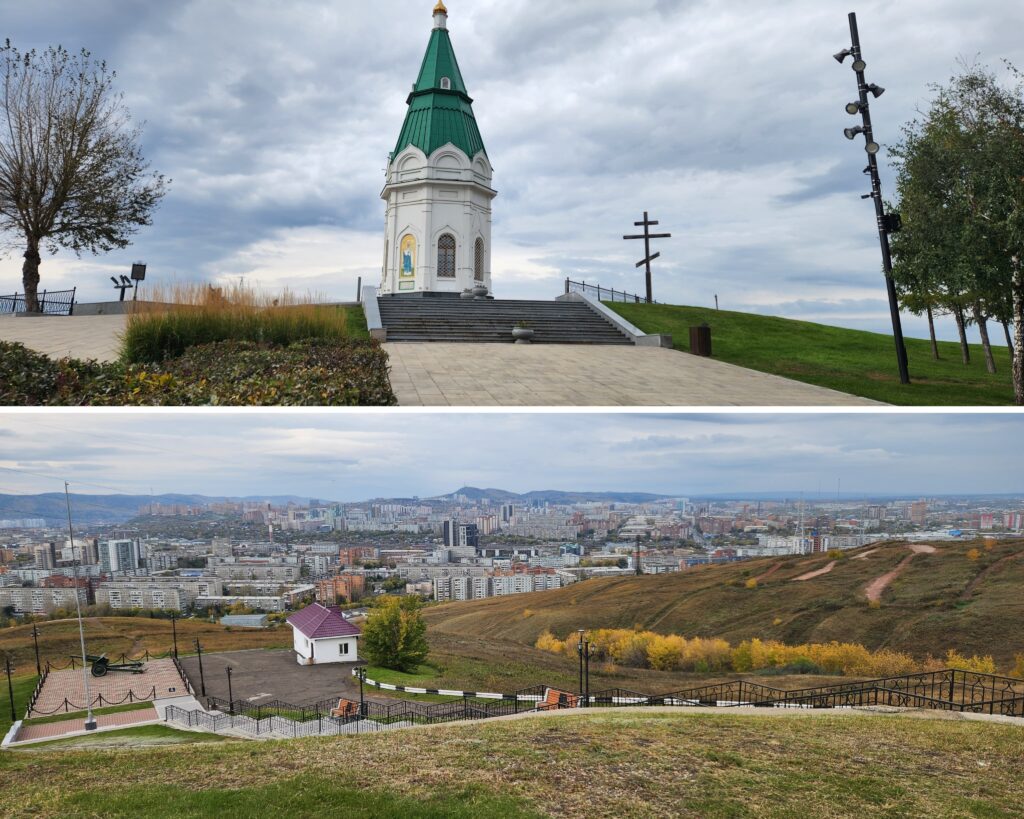
Paraskeva Pyatsina is a small chapel standing on the top of Karaulnaya mountain in Krasnoyarsk. This was once a pagan worship place of a local ethnic group but then the invading Russian cossacks ransacked the same and built a wooden chapel. Later in 1852, the wooden chapel was replaced with a stone chapel funded by a local gold miner and designed by Konstatin Thon, an architect who had designed the Church of Saviours and Kremlin in Moscow.
After a sumptuous lunch in a local restaurant, we proceeded to Krasnoyarsk railway station to board our 3rd leg of train journey from Krasnoyarsk to Irkutsk. The incoming train from Moscow was delayed by 4 hours. The waiting hall in Krasnoyarsk station was quite comfortable but still it was a little tedious to be kept waiting doing nothing. We boarded the train around 6 in the evening and started settling down in our berths.
Day 9-October 1st 2024-Irkutsk
The train was schedule to arrive in Irkutsk at 8 in the morning but arrived at 1 in the afternoon. Earlier, Russian railway was kind enough to provide a complimentary meal (noodles, cookies and water) to compensate the inordinate delay. The locals claim that the trains are never late and but then we need to blame our own bad luck. This time all co-passengers in my cabin unfortunately could speak only Russian. I tried my level best to communicate with one gentleman and understood that he had boarded 2 stations after Moscow going to Ulan-Ude and his total travel time was 4.5 days.
After a quick refreshing lunch at a local restaurant in Irkutsk, we ventured into finding out the trails of Irkutsk assisted by our local guide.
A short note on Irkutsk
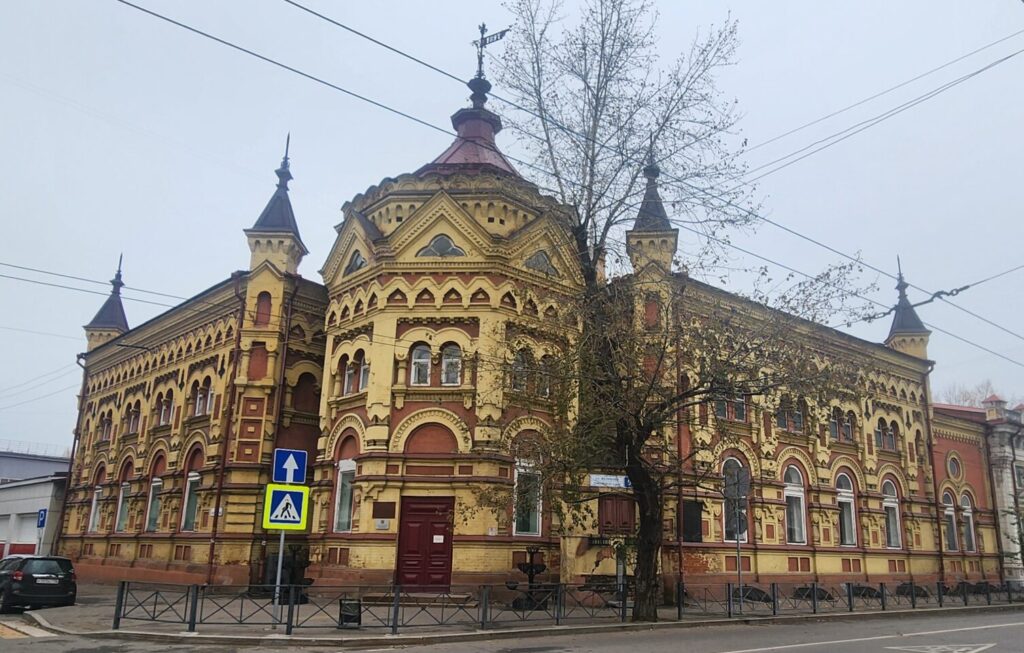
Google search for Irkutsk always returns with the image of the above aesthetic building. Initially, I mistook it for an important landmark here but later understood from our guide that its a private building not far from our hotel. Fascinated with its rustic look and bright colors, I visited here with google map assistance during my morning walk. This mansion now serves as Children and Youth creativity center of Irkutsk. Could you spot the metal flag at the top of the building inscribed with the year of construction (1897)?
Russian cossacks occupied Irkutsk in 1661 after overpowering Buryats, a Mongolian ethnic nomadic tribe. After its annexure with the Russian empire, Irkutsk served as as an important trade route between China and Euro-Russia. Later, the Trans Siberian railway added impetus to the industrial growth of Irkutsk and Eastern Siberia.
Irkutsk lies on the banks of River Ankara and has a population close to half a million (5 lakhs). It is the capital of Irkutsk Oblast in Eastern Siberia. Lake Baikal, world’s largest fresh water lake is 65 kms from Irkutsk. Yakutsk (Republic of Sakha) considered the coldest city of the world is 3000kms north of Irkutsk.
130 Kvartal
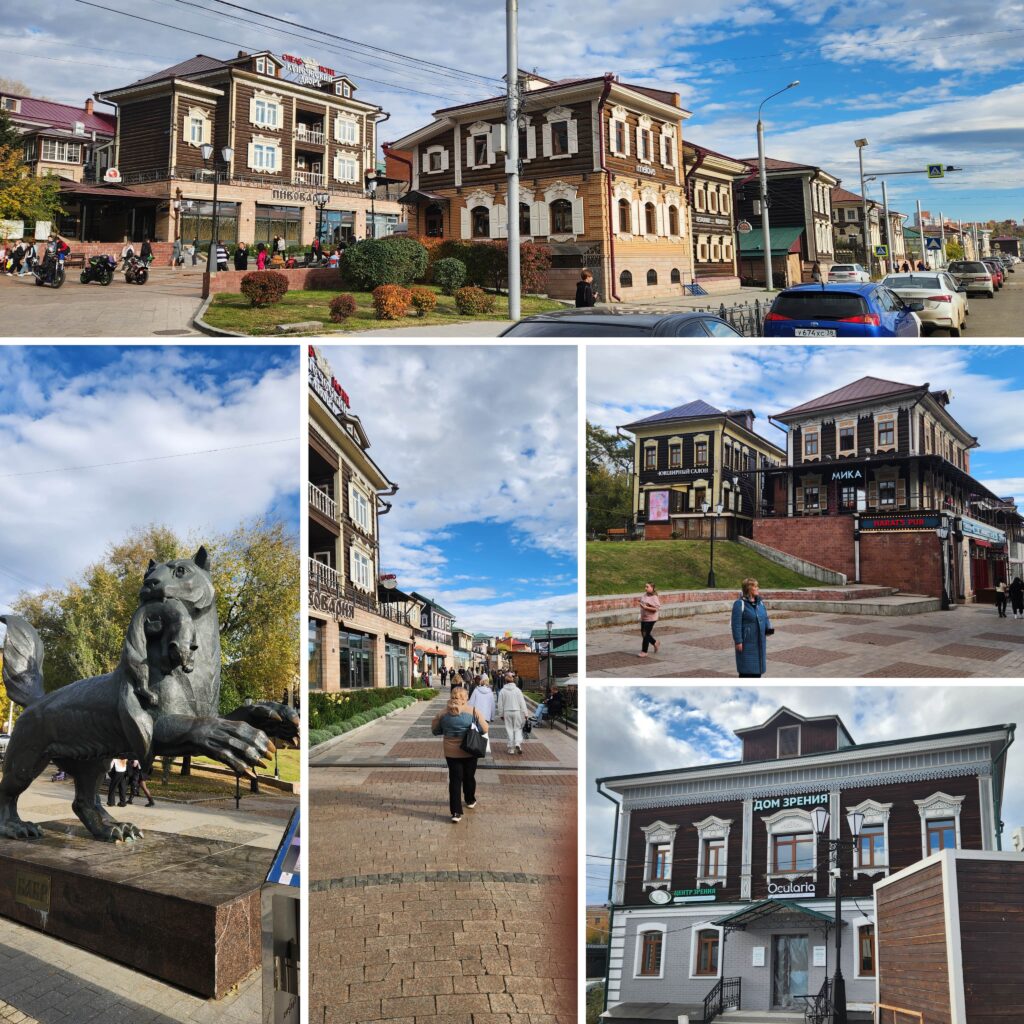
The cossacks initially built a wooden fort before raising the city of Irkutsk and always preferred wooden construction for its natural insulating quality. Irkutsk was soon populated with serial wooden buildings and was popularly known as “City of Lace”. Irkutsk was also called ‘Paris of Siberia’ after the settlement of Decembrists exiled to Siberia (please read about them in the next section). Thanks to their aristocratic roots, the Decembrists contributed in enhancing the culture and refinement of the city and also added their share of huge wooden houses with ornate decorations. Unfortunately, a major fire in 1879 razed almost all the wooden buildings to ground.
Today,130 Kvartal (130th Quarter) is a street with wooden buildings restored and rebuilt to showcase how ‘Paris of the East” once looked. Its was a very pleasant experience walking down the street with a assortment of cafes, restaurants, bars and souvenir shops all fabricated with wood.
At the entrance to 130 Kvartal stands the statue of Babr, the official symbol of Irkutsk (please see the photo above). It is a mythological monster conceived by a local artist blending a Siberian tiger and a beaver with a sable in mouth as prey.
Decembrists and Trubetskoy house
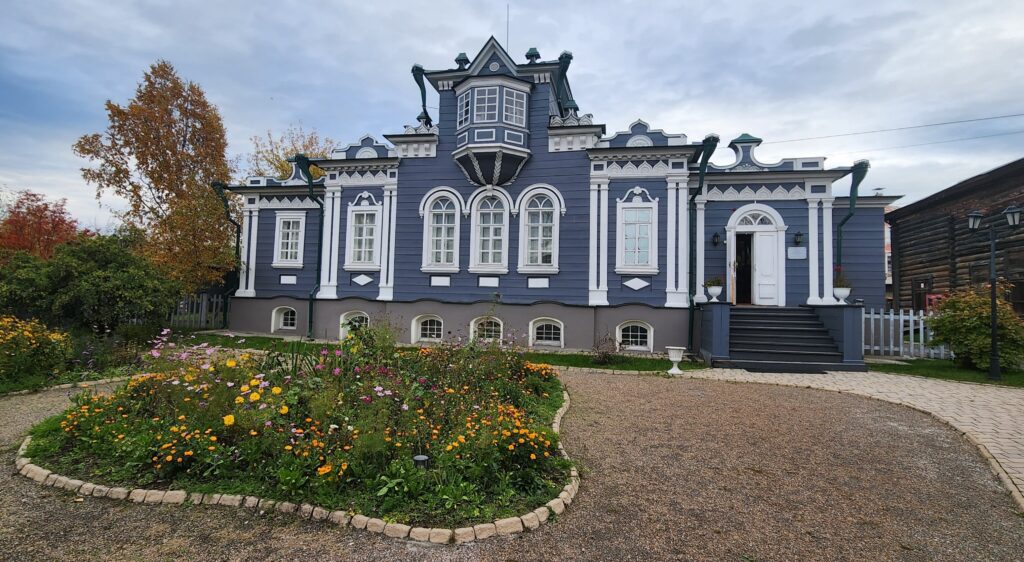
In 1825, when Nicholas-I ascended the throne after the demise of Tsar Alexander-I, a group of Russian officers and members of nobility commanding 3000 soldiers led a revolt against Russian Imperialism. Since the revolt happened in the month of December, this revolutionary group was called Decembrists. Led by Sergei Trubetskoy, the Decembrists demanded liberalism with abolition of serfdom (a kind of slavery) and righteous acts favouring poor peasants. Nicholas-I crushed the Decembrists with ease but spared Trubetskoy and the Decembrists from death sentence as Trubetskoy himself belonged to an aristocratic noble family with large influence. The Decembrists were instead sentenced to exile in Siberian prisoner camps.
Trubetskoy was foreseen as a great reformer to Russia as was the contemporary George Washington to the US but miserably failed.The above mansion was built by the Trubetskoy’s daughter and houses a museum today depicting the life of banished Decembrists.
The Church of Lady of Kazan
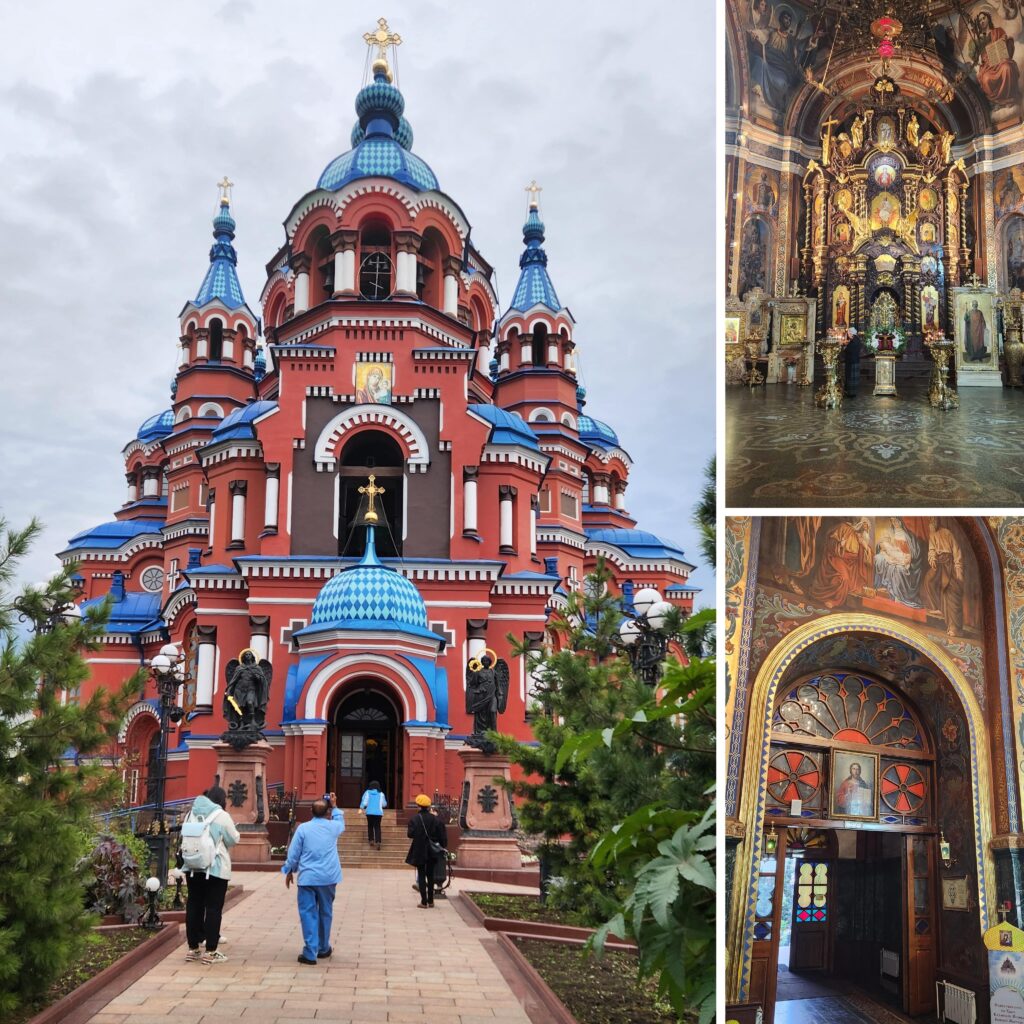
Our Lady of Kazan Church is a Russian Orthodox church built in the end of 19th century and dedicated to the Mother of God of Kazan, representing Virgin Mary in Russian orthodoxy. The classic Byzantine style architecture looks stunning with the vibrant red colored walls and blue colored tombs adding to its beauty.
Kirov’s park-Part 1
To see the landmarks in Irkutsk is quite easy as everything is in a walking distance around Kirov’s park. Though named as a park, it is officially a Square (Plashod in Russian) surrounded with the meandering Angara river, cathedrals, serene gardens, trees with fall colour leaves, administrative building for Irkutsk region and monuments. In winter, the square gets adorned with many beautifully carved ice sculptures.
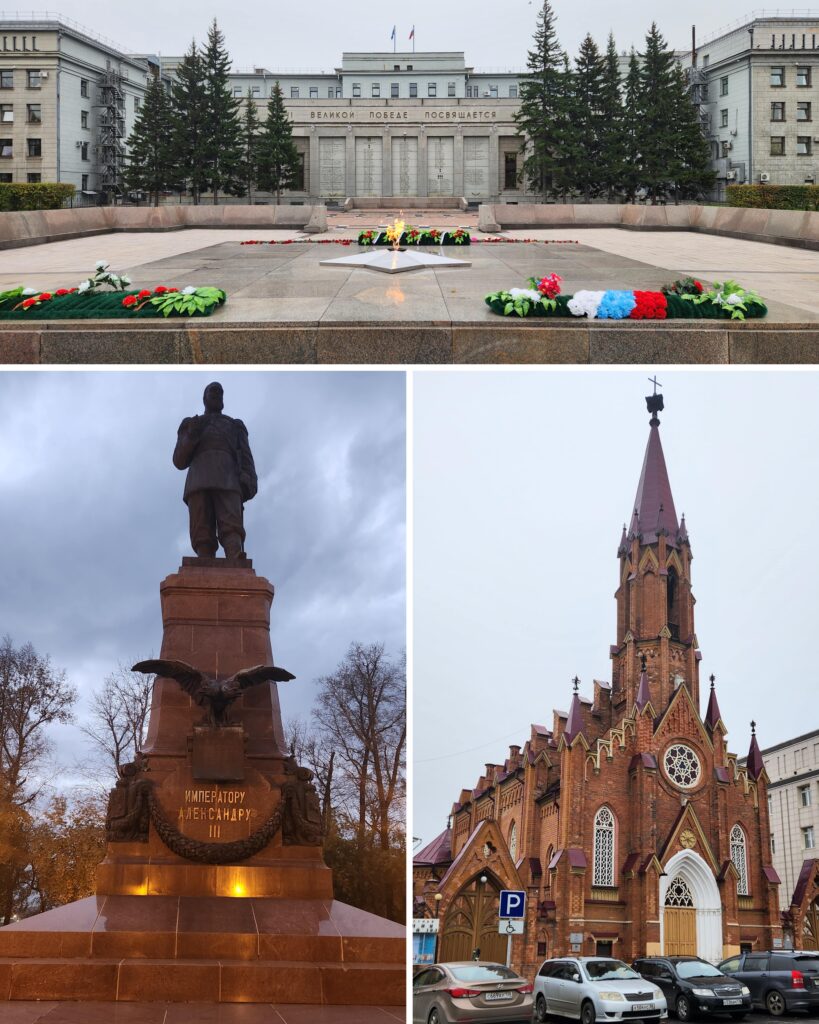
Siberia always remained in bad limelight in Russian history as it was the preferred choice for deporting convicts and prisoners. Its extreme harsh weather and tough terrain added with forced labour were nothing short of a death sentence. Popular prisoners exiled to Siberia were The Decembrists, Nicholus-II family and the people convicted by Stalin during the Great Purge. Adding to the list were the Polish prisoners of WW2 sentenced to these Siberian concentration camps. The surviving Polish prisoners later settled in Irkutsk and built a wooden chappel in the early 19th century only to be ravaged in the great fire of 1879. Thereafter, the polish settlers rebuilt a stone cathedral in neo-gothic style as seen in the above image. This is the only Roman Catholic Church that we saw in Russia though our guide said there are a few more.
Russia bore the major brunt of World War 2 initially associating with Germany and occupying eastern Poland but later changed sides with the Allied forces fighting the German Nazis in the east and Japan in the west. Russia suffered maximum casualities before forcing Germany to surrender. The WW2 monument and the eternal flame was dedicated in 1980 in honour of the Siberian warriors who have laid their lives fighting the deadly war.
It was the vision of Tsar Alexander-III (1881-1894) to connect Europe to the Pacific with a mega rail route across the Siberian region. The hero of Trans Siberian rail project is honoured with a statue in Irkutsk on the banks of Angara River.
Day 10-October 2nd 2024-Irkutsk
Kirov’s park-Part 2
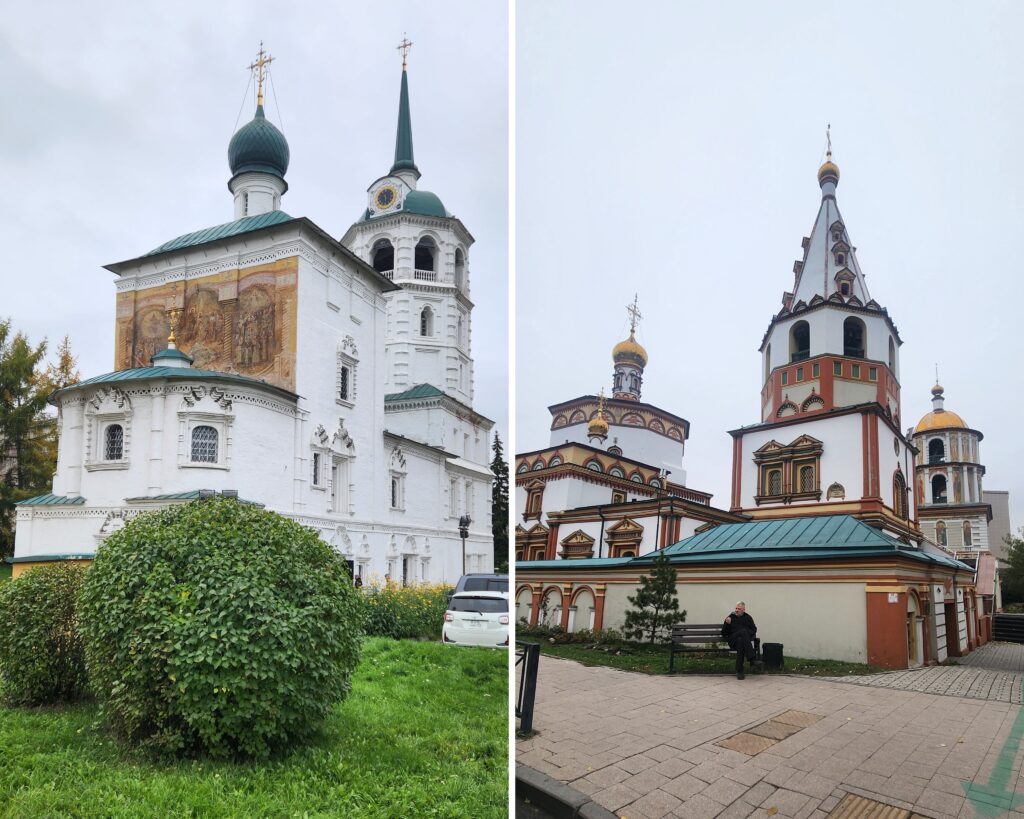
The Spasskaya Church diagonally opposite to the Polish RC Church across the Kirov square is the oldest church in Irkutsk dedicated to the founders of the city. The unique frescos on the outer surface blending with the white colored walls and green domes are quite impressive.
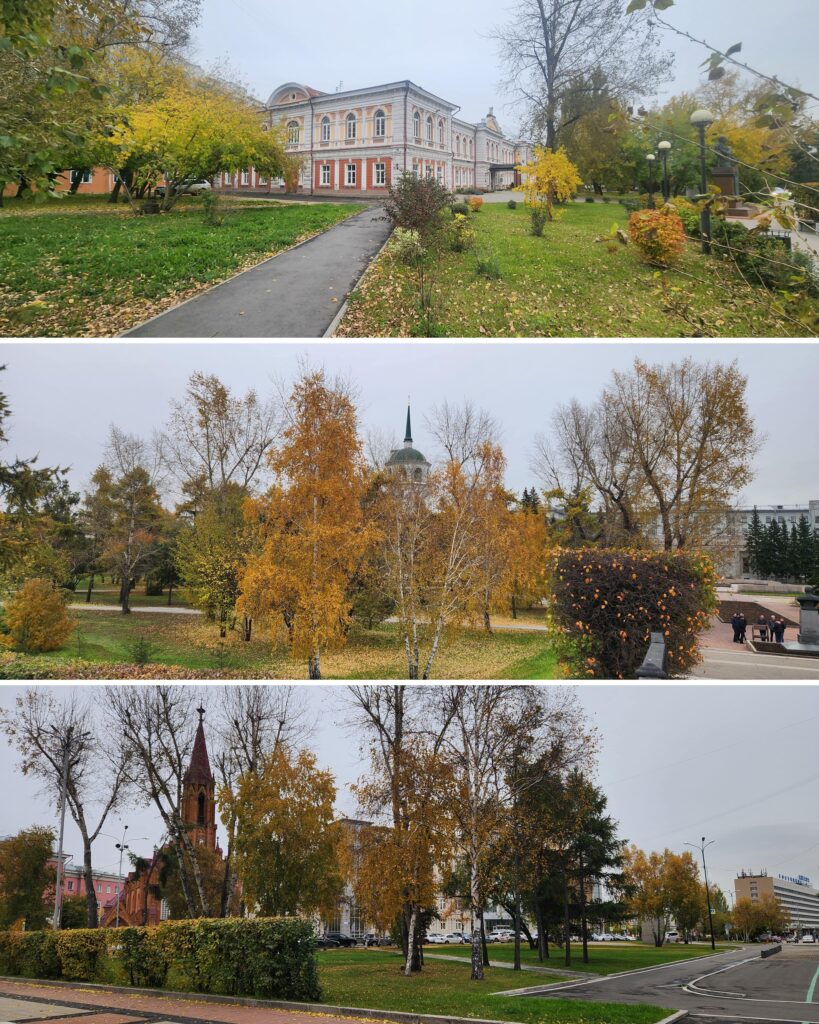
Church of the Epiphany (Sobor Bogoyavlensky in Russian) is another marvellous orthodox church in the Kirov square area. Built with a blend of Russio-Gothic architecture, its the 3rd church in Kirov park.
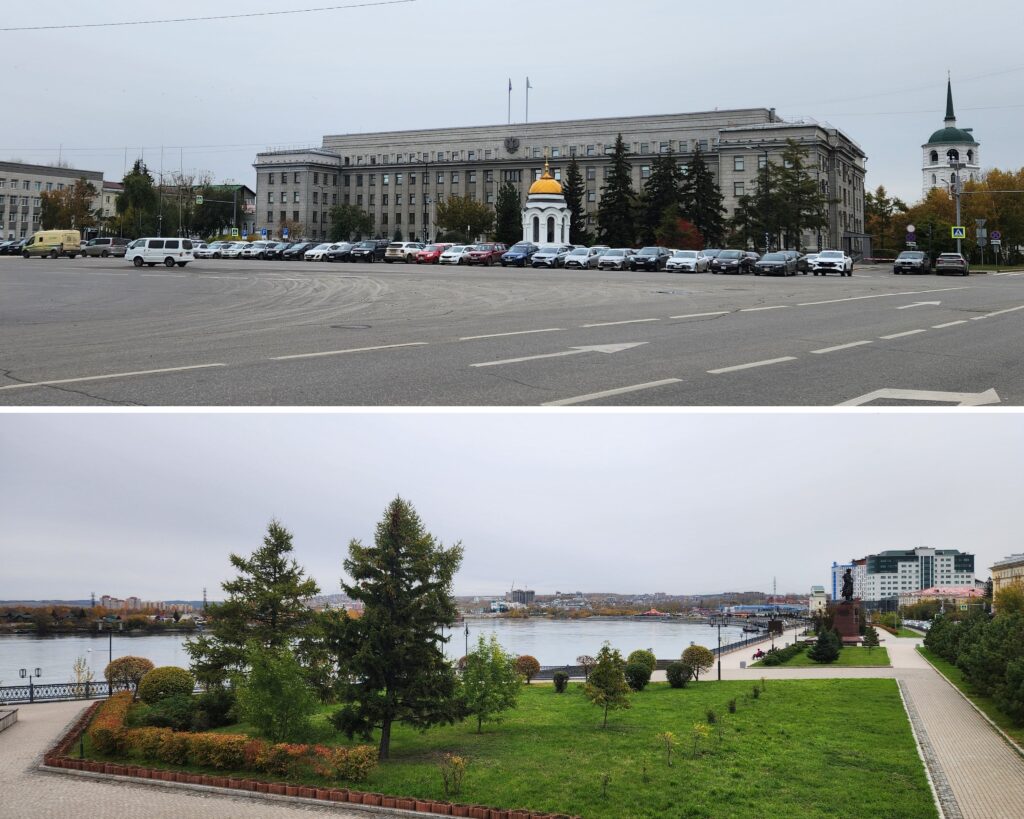
Tal’sty museum
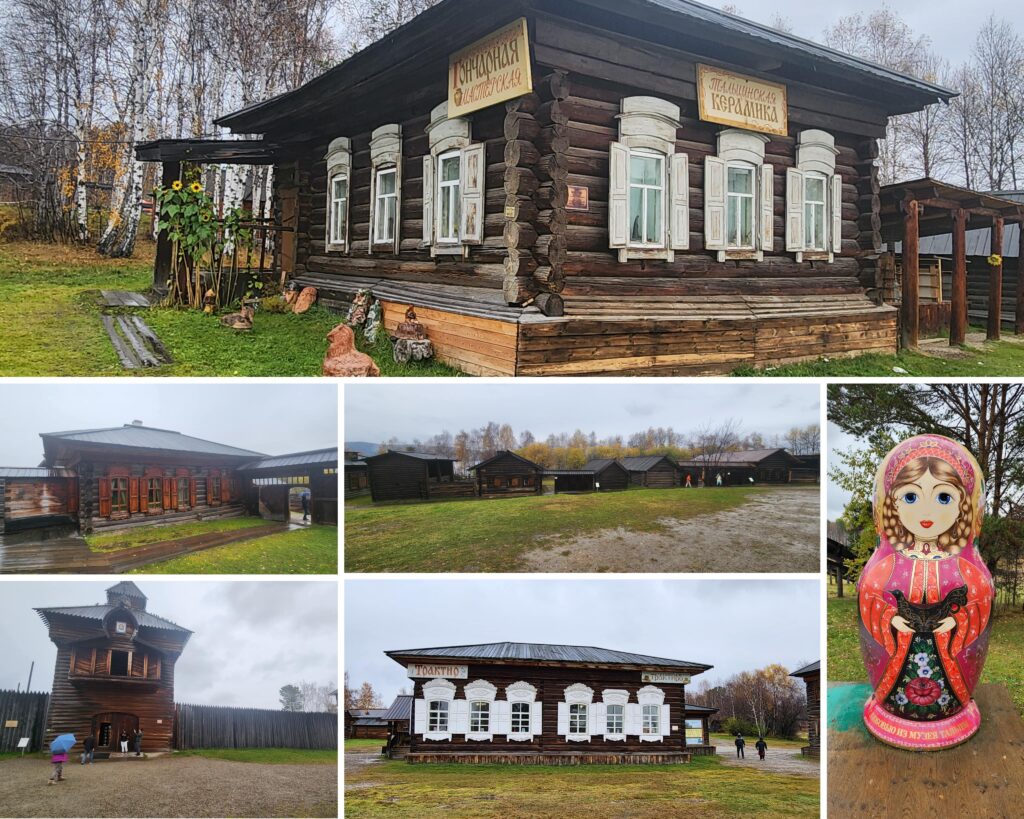
When Irkutsk dam was planned across river Angara, the blue print clearly revealed submersion of many surviving wooden buildings in the vicinity. The local administration thoughtfully established an open air museum, 45kms south of Irkutsk and relocated these wooden structures here. This uniquely curated museum on the banks of Angara illustrates the culture and lifestyle of the aristocrats, cossaks and the peasants who had lived in this part of Siberian area. Tourists heading to lake Baikal never miss to visit this strategically located museum on Irkutsk-Lake Baikal road.
Lake Baikal- a natural wonder of the world
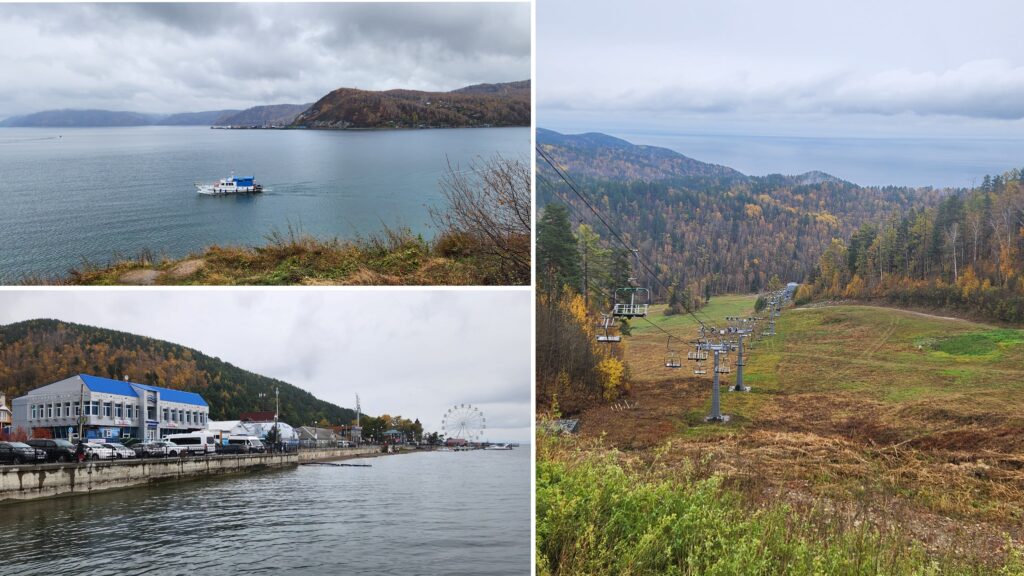
Listvyanka is a beautiful hamlet, 70kms from Irkutsk city centre on eastern bank of Lake Baikal.
Lake Baikal, a UNESCO world heritage site is the deepest lake in the world with maximum depth reaching an astounding 1642metres. Just to understand Baikal’s magnitude, lets compare the depth of other massive fresh water bodies in the world. Caspian sea, world largest lake is 1025m deep but its status as lake is often renounced due to its high salinity. Next comes Lake superior in Canada, the 2nd largest lake with a maximum depth of 406m (just 25% of Lake Baikal’s depth).
Lake Baikal stores 22% of earth’s total fresh water. Baikal is fed by many perennial streams all around its perimeter but overflows at only one outlet near Listvyanka and it is here River Angara is born. This natural water cycling pattern presents another astonishing statistical phenomenon when Baikal gets completely renewed with fresh inflow over 383 years. RiverAngara continues to flow northwards passing through Irkutsk city before joining the Yenisey river.
Baikal is the most ancient lake in the world formed 25million years ago after a major continental rift. Incidentally, its the 7th largest lake in the world by area (636kms long and 80kms wide).
The water transperancy in certain open sections of the lake extends upto 30 to 40metres. The water is not only clean, it is also rich in oxygen content even at deeper levels with balanced mineral deposits. No wonder, the lake is home to thousands of biologically diverse flora and fauna and 80% of them are endemic (cant be seen else where). Just to name a few endemic species lets start with Baikal seal – the only fresh water seal in the world locally known as Nerpa. Another popular, highly nutrient and most consumed fish is the Omul Salmon. We were served with smoked Omul fish for lunch in a local restaurant in Listvyanka. Baikal Sturgeon is another endemic and ancient fish that grows 10feet long on an average.
During peak winters, water in the lake freezes upto 2metres on the surface and gets so fortified that even a train could run over it. Baikal gets completely frozen and the transport system shifts to hovercrafts, cars and trucks throughout the long winters.
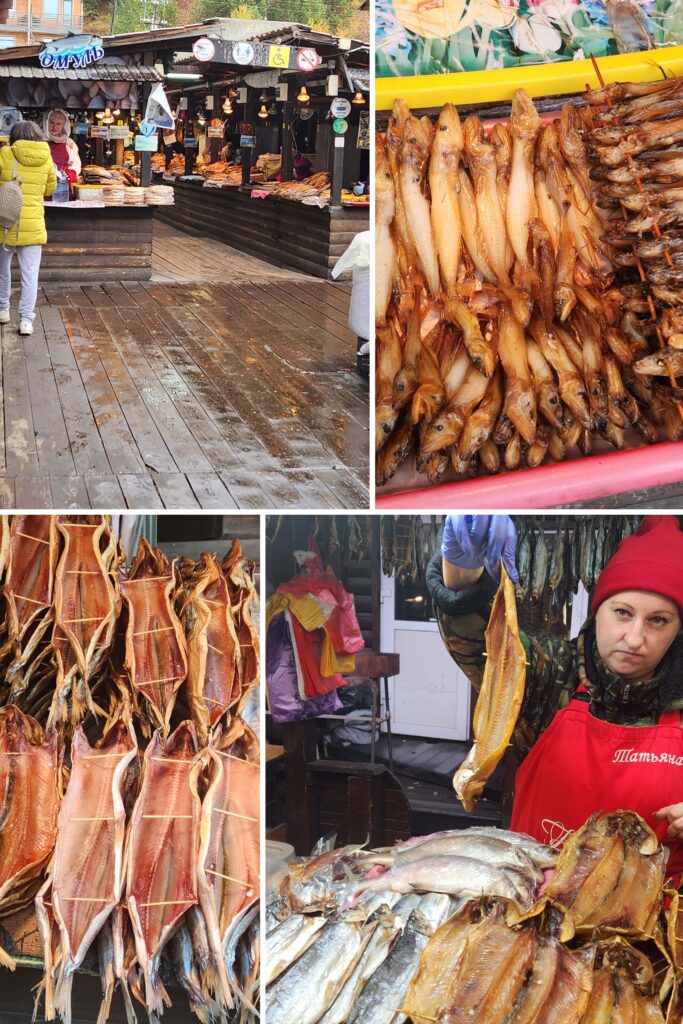
Listvyanka has a ski resort, many souviner shops and a huge fish market selling fresh catch from lake Baikal.
We returned to Irkutsk late in the evening and ended the day with dinner in Hotel Ganga, an Indian restaurant run by an Indian who studied medicine in Russia.
Day 11-October 3rd 2024-Train Travel
Travel to Mongolia
Today morning, we boarded the the last leg of our train journey from Irkutsk crossing country borders to reach Ulaan Baatar, Mongolia. This was certainly the best part of the whole Trans Siberian experience as our train maneuvered along the curving bunds of the beautiful Lake Baikal. We were also fortunate to see some snowfall midway reminding the approaching winter. Please watch the video below picturizing those beautiful moments.
It was a bright afternoon as we reached Ulan Ude, a Russian city close to Mongolian border. Its is here the train to Mongolia deviates from the conventional Trans Siberian route and travels further deep south towards the international borders.
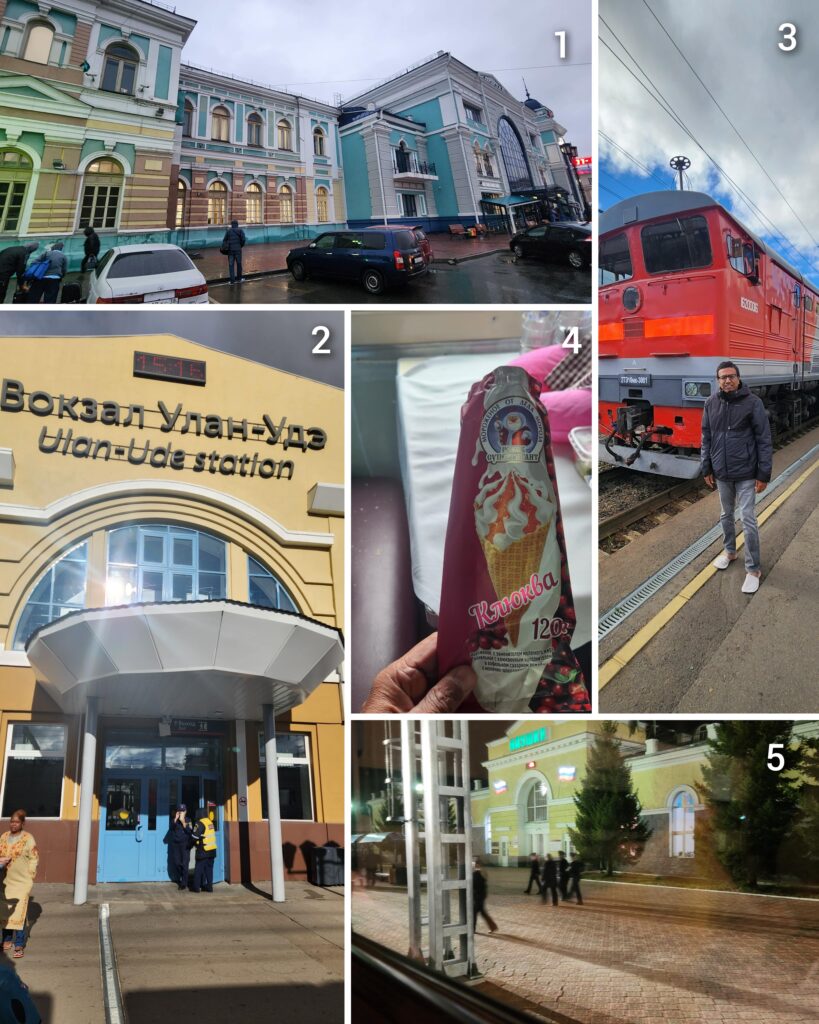
Immigration at Russian-Mongolian border
It was eight in the evening when we reached Naushki, a city close to Russian International border. Another gruelling emigration experience unfolded as Russian passport control officers boarded our train and locked the doors and toilets. They started inspecting our baggages and collected our passports for stamping after physical authentication.
In another 20minutes of travel, the train halted again at SukhBaatar, Mongolia’s international border city. The Mongolian immigration officials clad in green uniforms repeated the protocol similar to the Russian border. Additionally, we were subjected to customs rituals and anti-narcotics sniffer dog squad inspections. As things were settling down, I peeped out of our cabin door to find the wagon attender climbing a ladder and opening up the wagon’s ceilings. I am sure they were on a lookout for drugs but was wondering how the hell the dreadful menace is getting so common inspite of such stringent measures globally. It was almost midnight and the train continued its journey in the Mongolian land. Everyone looked exhausted after this four hours ordeal but then thats how traveling becomes more challenging and interesting.
Kudos to Trans Siberian train wagon attenders
At this point, I wanted to mention about the train wagon attenders as I see them as the true representative of Russian work culture. Every wagon is assigned with one attender, mostly females. Her work begins when she stands at the wagon entrance checking passports and tickets of bonafide passengers. She then provides bed linen and travel kits, reminds the passengers when their destination approaches and collects the used linen when the berth is vacated. She supplies the traditional fresh coffee mugs on request and washes/dries them on returning. She also collects trash and cleans the cabin with vacuum cleaners, cleans the toilets and even mobs the floor with towels. On reaching intermediate stations, she pulls down the collapsible wagon door stairs and waits in the platform braving the cold to enable passengers boarding and rolls back the stairs before departing. It happened that once when a male attender stuck a printed notice announcing a faulty bathroom door, I curiously looked inside his janitor room and found a laptop and a printer among a heap of used linens. And his/her toughest part was during immigration at Russian-Mongolian border when they had to handle both the immigraton officials and the restless passengers. And I observed them working non-stop for 24 to 36hours.
Day 12-October 4th 2024-Ulaan Baatar
As we woke up, the train was entering Ulaan Baatar, the coldest capital city in the world. As a justification to its title, the city welcomed us with a -6°C in autumn.
A short note on Mongolia
Mongolia is a landlocked country with Russia and China sharing its borders with the Gobi desert on the south occupying 30% of it’s total land area. Two third of Mongolia is filled with pasture lands and golden grassfields owing to its semi arid climate. No wonder Mongolia is the most emptiest country in the world with just 2 people in one square kilometre (against India having 488 people in one square kilometer). The population of entire country is just 3.5million.
Mongolia is also known a ‘land of eternal blue sky’ as the sky is clear and blue for 250days in a year due to dry weather and low precipitation. The summers are warm and the winters are extremely cold. It seems last winter, Mongolia recorded a historical low of -40°C and lost thousands of cattles to extreme cold temperatures.
Mongolian economy is driven by mining, live stock farming and recently growing tourism and services industry. I would personally wish to add another title to Ulaan Baatar as ‘city of cars’. The city roads overflow with cars and not many buses or trucks were seen. Apart from Ulaan Baatar, there are many smaller cities in Mongolia like Erdenet and Darhan to name a few.
Genghis Khan-Hero of Mongolia
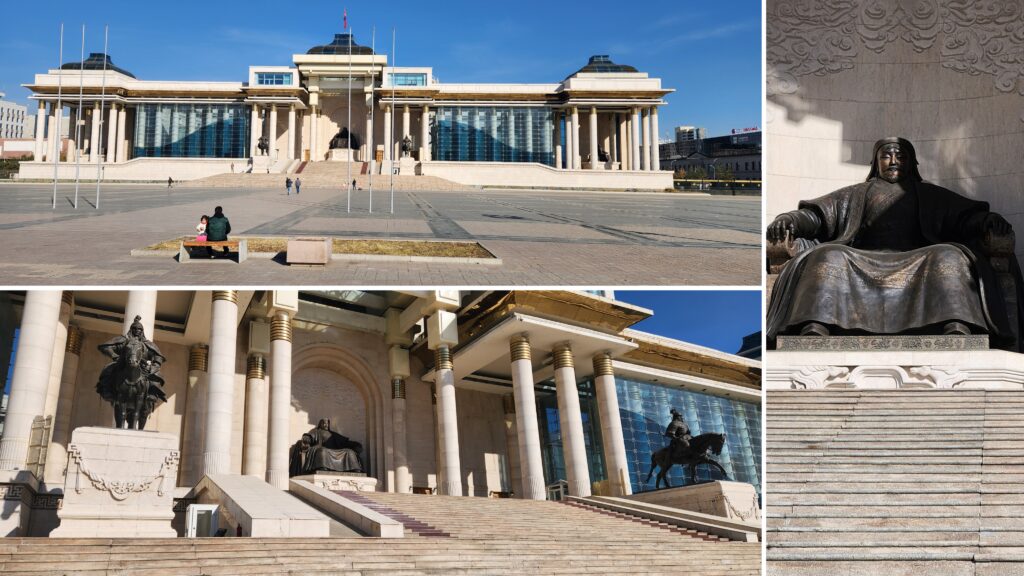
Genghis Khan has left behind an implausible imprint in world history. He is known as Chinggis Khan (translated as Universal leader) in Mongolia and is celebrated as a national hero. Even Ulaan Baatar airport is named after him and Mongolian currency (Turgik) carries his image. It’s only in the western world, he is known as Genghis Khan.
Born as Temujin in 1162CE to a poor Mongolian tribal family, Genghis Khan’s arduous and very challenging childhood probably moulded him to become the most prominent emperor in world history. His humble journey started with gathering and uniting the conflicting nomadic steppe tribes to build a formidable empire in today’s Mongolia by 1205CE. He was well supported by his generals Muqali and Bo’orchu in his initial invasions.
He slaughtered millions of people in his lust to expand the empire but his brilliant military strategies and commendable administrative reforms paved way for his glorified stature. He enforced strict laws against cattle thefts, kidnapping women and slavery that existed for centuries among Mongolian tribes. He even allowed freedom of religion and conducted census regularly. He encouraged healthy trade practices and ensured flourishing goods exchange along the major silk routes in his empire. It was just amazing to learn that he never allowed his image to be portrayed in painting or monuments until he lived.
It was goose bump moments as we stepped into the land of Genghis Khan. It also gave me an opportunity to learn and debunk some of my own myths and understandings of Genghis Khan. If you have already read about him, I request you to pardon my ignorance and move to next topic. Here I go, decoding them one by one as highlighted in bold/italics below.
- Genghis Khan is a Muslim: No, Genghis Khan is not a Muslim. We often get confused with the surname ‘Khan’ and tend to associate him to a Muslim. The Khan here is derived from the Turkish word ‘Khagan’ meaning ‘chief or ruler’. This became a hierarchical title confered on Mongol leaders starting from Genghis Khan. The fact is he was a Shamanite and followed Tengrism/Shaminism worshiping mountains and the blue sky. As mentioned earlier, he was a pragmatic leader allowing Buddhism, Islam and Christianity to be followed in his kingdom.
- Genghis Khan invaded and ruled India: No, Genghis Khan never invaded India.Genghis Khan’s military prowess and strategy helped him lay seige on the Xi Xia kingdom in north-western China in 1209CE. In the next 3 years, he invaded the whole northern China until Zhongdu (now Beijing) after overpowering the Jin dynasty. In 1219, he set his eyes on the eastern part of Mongolia marching successfully through Turkmenistan, Uzbekistan, Afghanistan and Iran. Everything happened within a shortest time ever rcorded in history. It was his decendants Ogedai Khan and Kublai Khan who followed their father footsteps and further expanded the territory and at one time at its peak, 20% of world was under the Mongol empire from Japan in the Pacific to Eastern Europe.
- Babur and the Mughal dynasty are direct decendents of Genghis Khan: Babur is more a Turkic origin and is a direct paternal decendant of Amir Timur, a sunny muslim and founder of Timurid dynasty centred in Persia (today’s Iran). Babur has only a maternal lineage traceable to Genghis Khan but separated by almost 13 generations.
GandanTegchilen monastry
Mongolia is predominantly a Buddhist country influenced and affliated to Tibetan Buddhism. Many monastries in Mongolia met the same destiny in the hands of Soviet Union similar to Russian Orthodox cathedrals. GandanTegchilen monastry or simply Gandan monastry established in 1838 was fortunate to escape Soviets demolition. Today, Gandan remains as the single largest and often visited monastry in Mongolia.
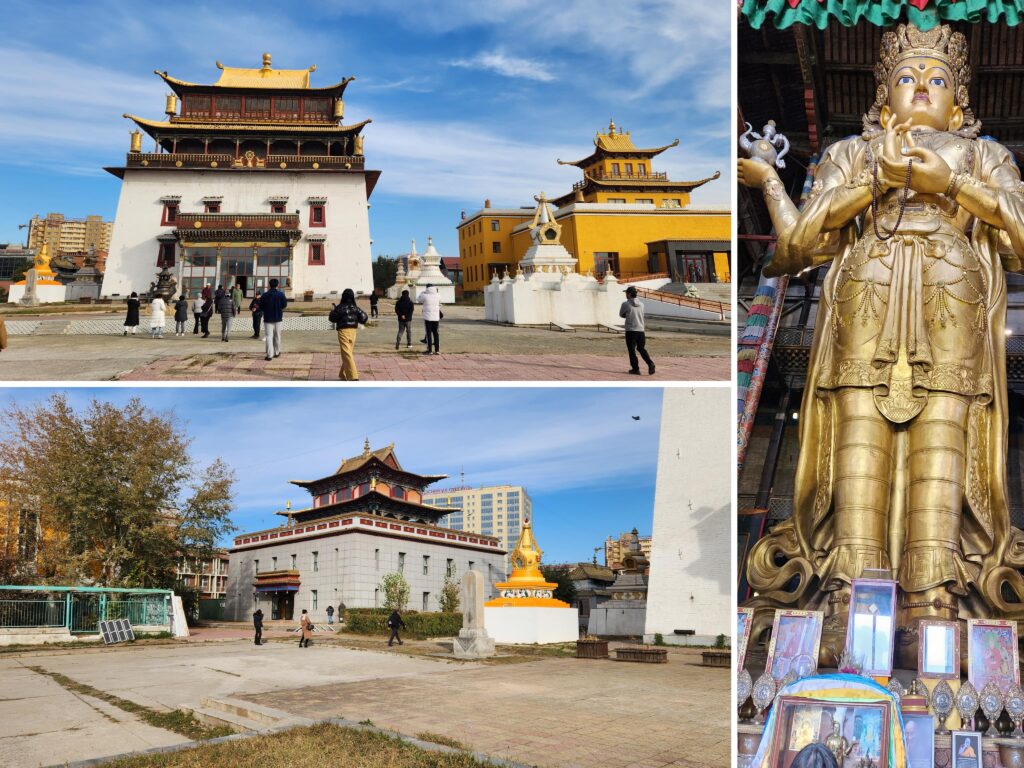
Gandan monastry is a huge complex in the centre of the city and houses many shrines, temples, assembly halls and schools teaching traditional medicine, astrology and Buddhist philosophies. The largest shrine houses an 85 foot statue of Megjid-Janraiseg, a Bodhisattva reconstructed after 1990. The original statue made of gold and bronze was razed down by the Soviets to make bullets. Zanabazar, revered as the first incarnation of Lord Buddha was born in Mongolia. He was also a renowned sculptor, painter and linguist and is regarded as the father of Mongolian Renaissance. Zanabazar sculpted his own statue on his mother’s request and the same is preserved and worshiped in Gandan monastry.
Gorkhi Terelj National park
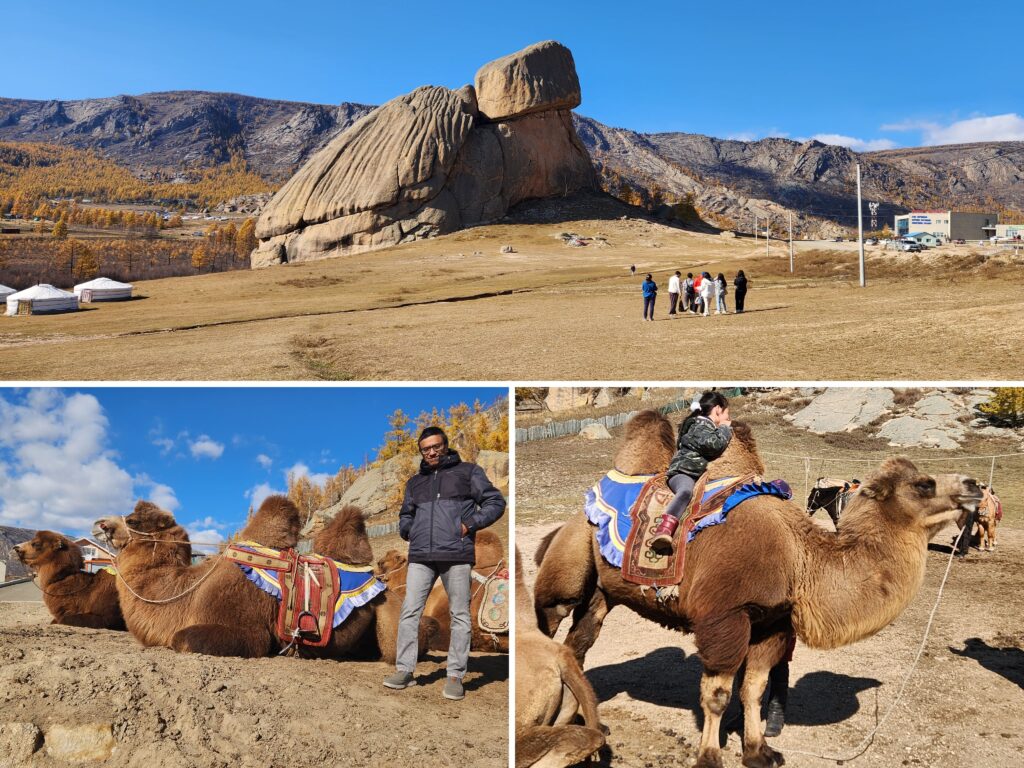
Gorkhi Terelj National park is 40kms from Ulaan Baatar and has become popular among western, Chinese and South Koreans tourists in recent times. The park has many unique rock formations and the Turtle rock is impressive. Tourists also gets an opportunity to see and ride the double humped Bactrian camel native to Mongolia.
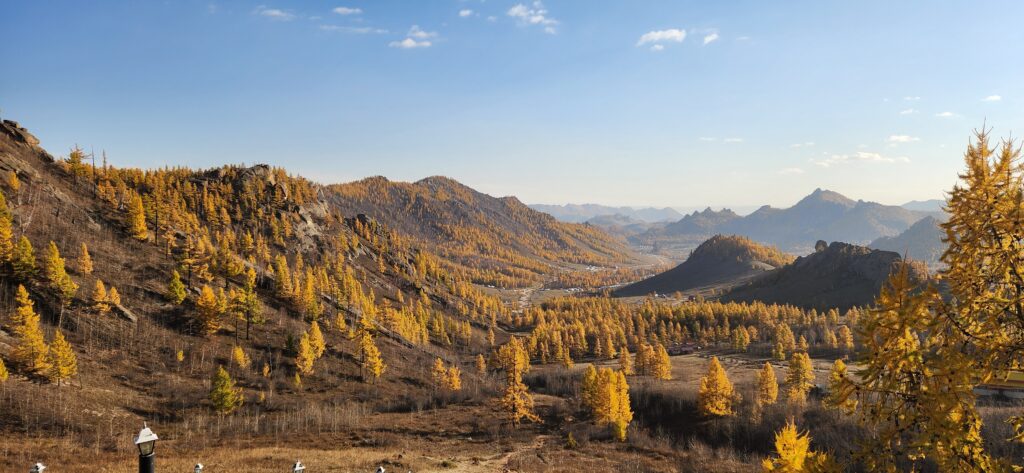
We also visited Aryabala temple, a Buddhist shrine in a hillock not far from the Turtle rock. We need to climb around 500 steps but the effort was worth the ambience on the top conducive to meditate and pray. The view of the surrounding mountains and the grasslands are breathtaking.
Gers-Home of Mongolians
Ger is the traditional home of the Mongolians nomadic tribes for centuries. Also known as Yurts in Central Asia, the Gers are believed to be designed by a Mongolian ethnic tribe called Buryats. The insulation and portability of these distinctive circular tents complemented the nomadic tribal lifestyle in Mongolia. Later, the mobility of Gers became their forte enabling them to shift at ease and settle down in new territories keeping in pace with the rapidly expanding Mongolian empire. It is believed that Genghis Khan himself had a palatial Ger driven by oxens in its entirity when the emperor changed bases. Though there are many modern buildings in UlaanBaatar today, a larger population in suburbs and rural areas still live in Gers.
Many sophisticated Ger camps have popped up around the Gorkhi Terelj National park targeting the tourists. We stayed in one such luxurious Ger camp for one night. Please watch the video of the Ger house that we stayed.
Day 13-October 5th 2024-Ulaan Baatar
Damdin SukhBaatar and his role in Mongolian history
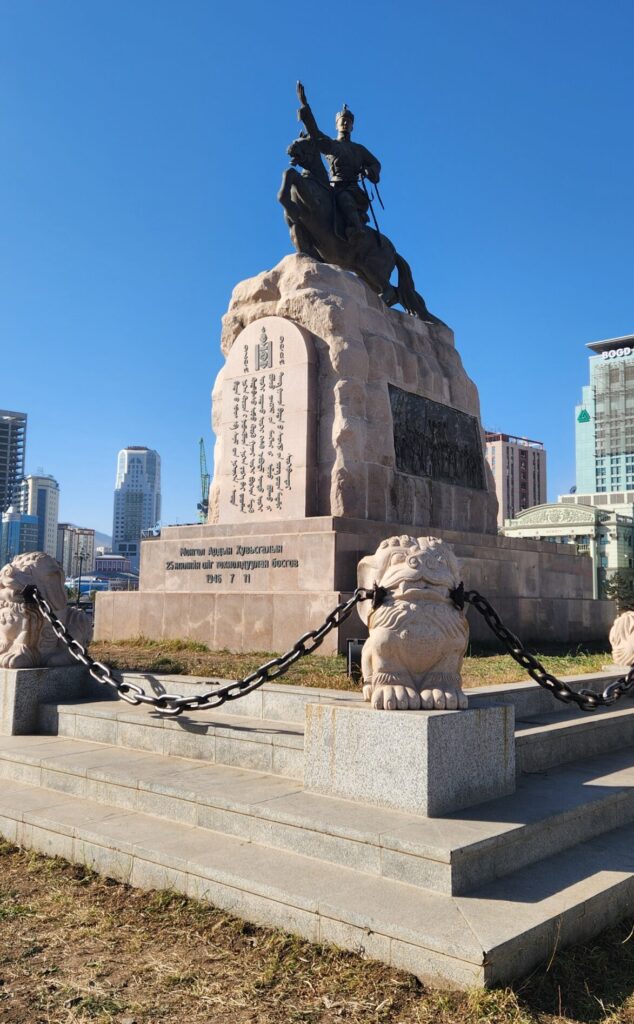
Damdin SukhBaatar is known as ‘Father of 1921 Mongolian Revolution’ and is another celebrated national hero in Mongolia along with Chinggis Khan. He was born in a poor Mongolian nomadic family in 1893 in today’s Ulaan Baatar. He joined the Mongolian army that was established after defeating the Qing dynasty in 1911. He continued to exhibit extraordinary skills and rose quickly to higher ranks in the army. In 1920, when the QIng dynasty attempted to invade and recapture Mongolia, Sukhbaatar formed a resistive force and even requested Soviets’ assistance to fight the invaders. After ensuring an independent Mongolia, he founded the Mongolian People’s party(MPP) and declared himself the Chief commander of Mongolian army. Unfortunately, SukhBaatar died very young in 1923 and reason of his death remains unknown.
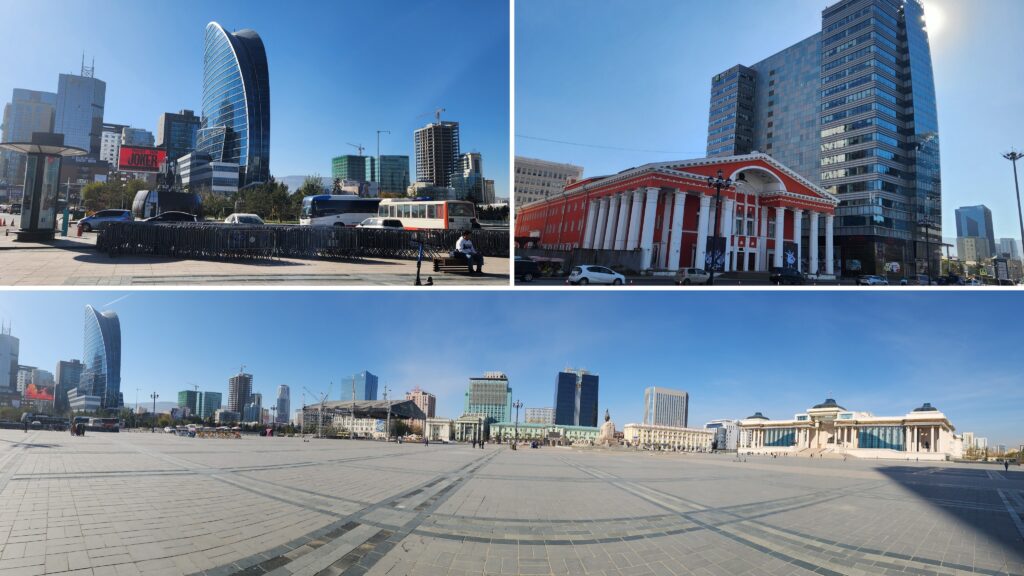
After Sukhbaatar’s untimely death, Mongolia was more a satellite state of Soviet Russia with just one entity namely the Mongolian People’s Revolutionary Party ruling the country for 65years. In 1989, when protests erupted against Soviets influence and demand for democracy, the national revolution led to scripting a new constitution. This constitution was adopted in 1992 asserting a completely democratic and sovereign Mongolia.
Sukhbaatar is remembered and honoured in monuments and Mongolian Tugrik (currency). The Genghis Khan square was renamed as SukhBaatar square with his monument gracing the centre of the square. You may remember city of SukhBaatar where we completed immigration in our train journey 2 days before.
As Trans Mongolian train terminates at Ulaan Baatar now, we need to fly to Beijing, China, the closest destination to get back home (to Chennai). We were tranferred to Chinggis Khan International airport in the evening to board MIAT Mongolian airlines. The flying time from Ulaan Baatar to Beijing was around 2 hours and we reached the Chinese capital around 8 in the evening.
Day 14-October 6th 2024-Beijing, China
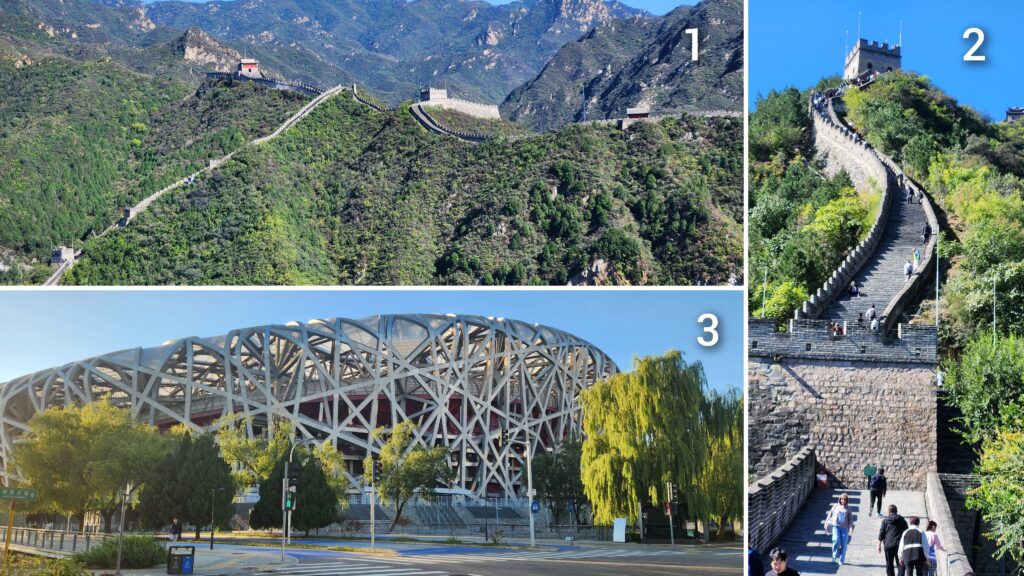
Beijing was once popularly known as the Forbidden city and the title looks still relevant but in a different context. All popular Indian/global mobile apps are forbidden here and even Gmail is not spared from the ban. We had tough times contacting our families back home when we landed. But on a positive note, these 3 days was a kind of detoxing from what I normally refer to as digital fat accumulated over years of gadget addiction.
Beijing in this trip was meant to be more of a transit destination. So we got to visit only Great wall of China and Beijing Olympic village during our 2 days stay in Beijing. As the focus of this trip was Trans Siberian railway, I reserve writing about China if ever I happen to make an exclusive visit in future.
Day 15-October 7th 2024-Beijing, China
Spasibo, Bayarlalaa and Xie Xie
All the above are thank you in Russian, Mongolian and Chinese. I thank all those who have reached this far patiently reading my post. It is your inspiration that drives me to travel and write as well.
As I completed this epic tour, one of my close friends out of the blue wanted my opinion about the world after having travelled to so many destinations in India and abroad. I really dont know what prompted him to ask me this simple but highly philosophical question. Travelling definitely opens up a new dimension to life and I am honestly attempting to seek answers convincing not just to my friend but to my own conscience.
God willing, see you all another time from another place.
End
An alumni of NIT,Trichy, living in Madurai-India, presently a freelancer and special volunteer in Madurai seed, a Madurai based NGO. Passionate about traveling – especially to off beat and historically significant destinations. Blessed with a compatible wife having identical interests. Writing travelogues is a spontaneous outcome of a dormant skill acknowledged and encouraged by friends.
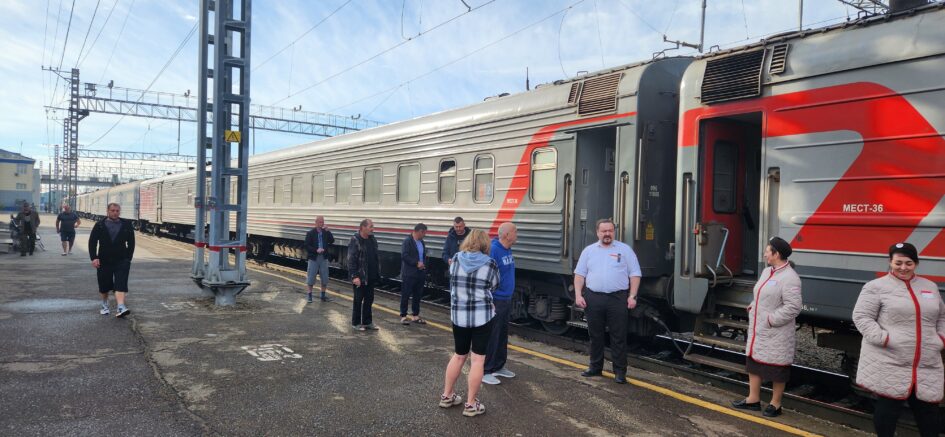
January 4, 2025 at 4:13 pm
This is the first time I have read your travel blog. Absolutely wonderful narration, great insights with just the right amount of detail and accompanied by beautiful pictures. I really enjoyed reading it and plan to read your previous blogs as well.
January 5, 2025 at 4:42 am
Wonderful experiences. Photographs and the write ups are great. It will serve as our guide book when we travel to these destinations.
Travel experiences mingled with history aling wirh beautiful photos make reading interesting. Great !!!!!!!!
January 5, 2025 at 12:21 pm
Wonderfully written! Your blog has made me excited to explore this journey myself someday. Thanks for sharing your Trans-Siberian rail tour experience and the adventurous immigrations!!!
Wishing you many more places to explore and write exciting blogs!
#movewithvimu
January 5, 2025 at 3:55 pm
I’d like to take a moment to appreciate the incredible experiences that shaped your journey and celebrate the wisdom, warmth, and curiosity you brought back. Your recent embarkation on an extraordinary adventure through Russia, Mongolia, and China, and as I went thru your stories, I couldn’t help but be filled with admiration and gratitude. Your travels not only allowed you to explore distant lands but also deepened my understanding of these fascinating countries. Thanks to this wonderful blog😊👍